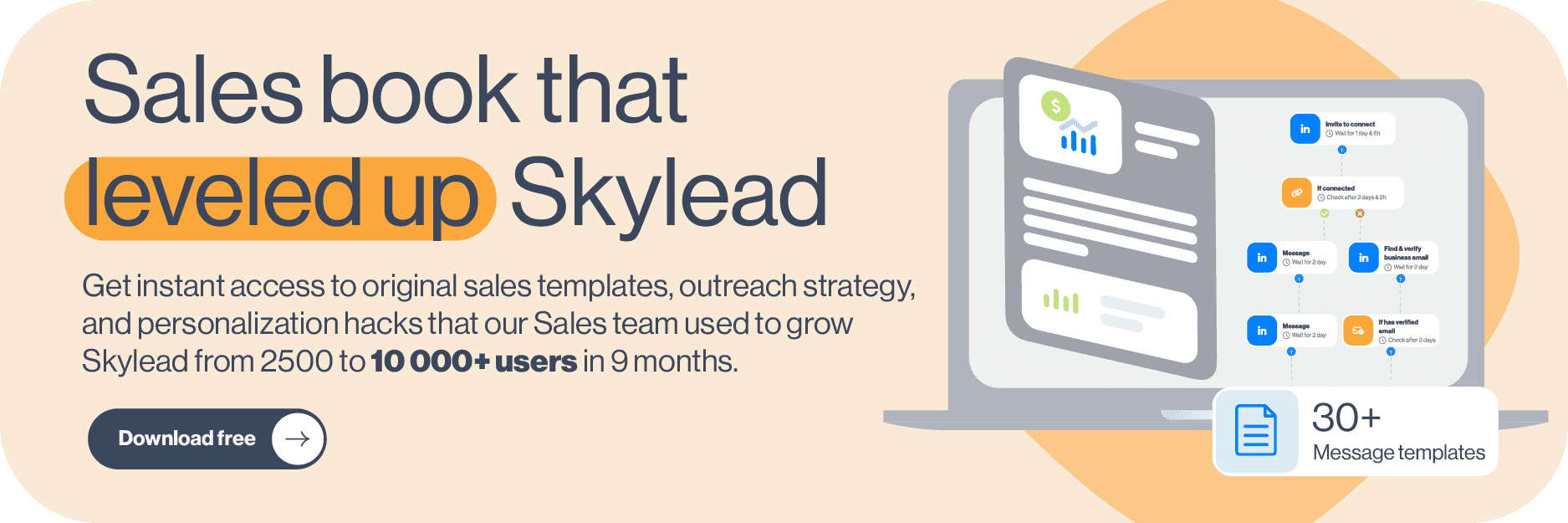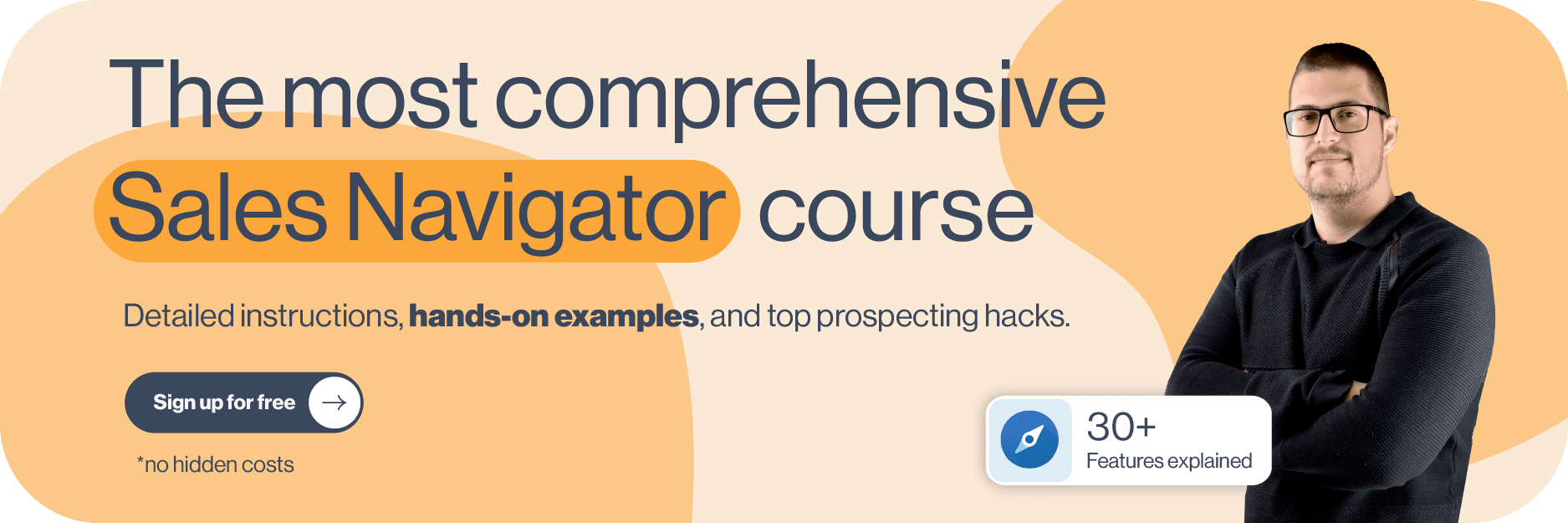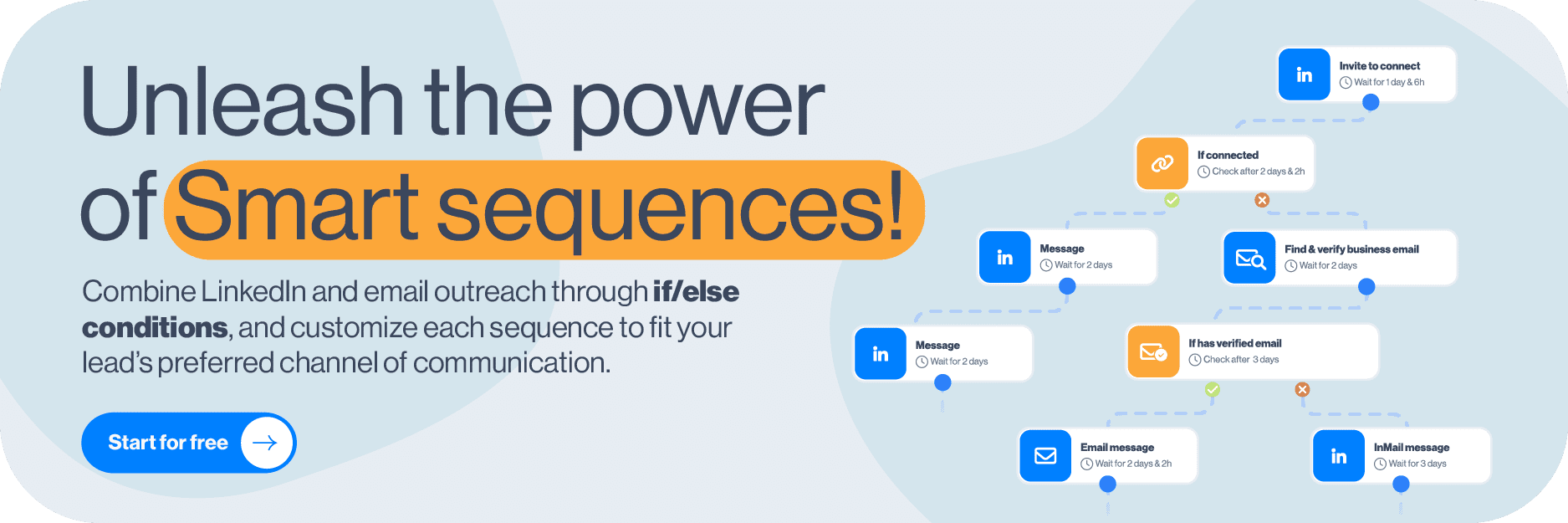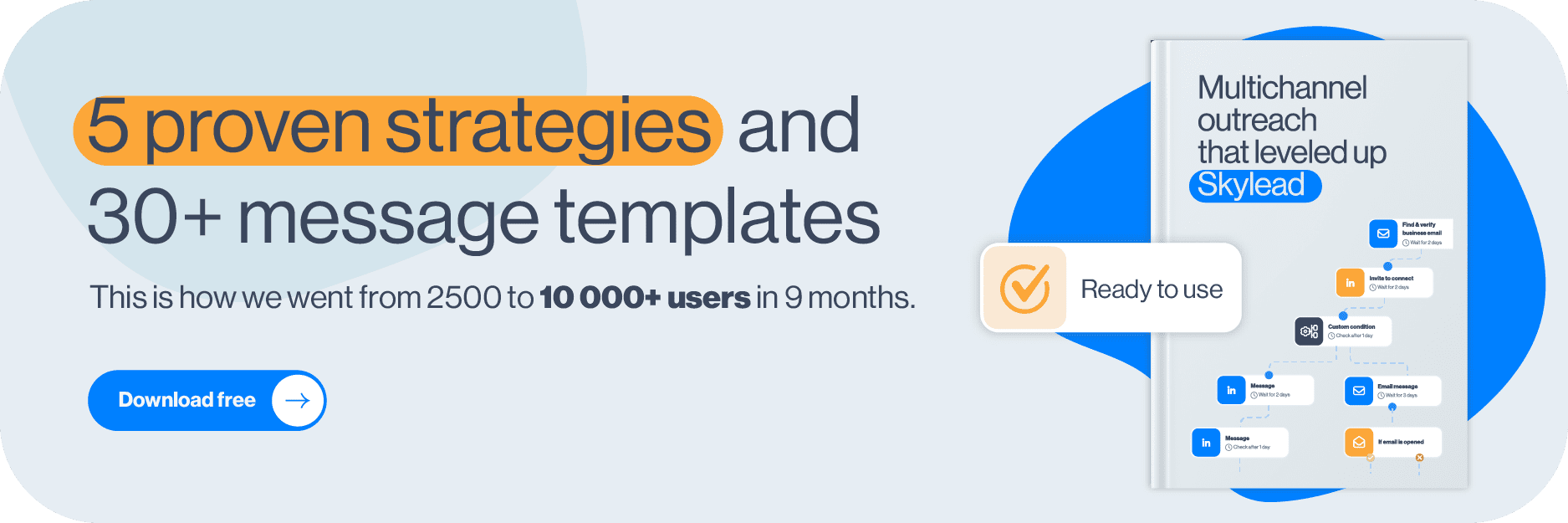Everybody knows that one of the best ways to get new customers is by contacting them using LinkedIn cold messages. Why? Well, sales teams prefer cold outreach via LinkedIn because this social media is the most effective B2B lead generation channel. Compared to cold calling, and cold emails, that is.
However, when crafting a LinkedIn cold message, salespeople often get confused about how to approach their leads. Or, for example, their cold outreach message ends up showing no effect at all.
That said, let’s make your cold LinkedIn outreach a winning game. In this article, we’ll focus on the best LinkedIn cold messages with demonstrated results where available. Moreover, we've prepared tips on how to write them.
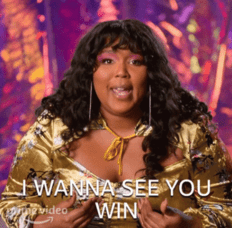
What is a LinkedIn cold message?
LinkedIn is the biggest social media platform for startups, company founders, CEOs, sales professionals, marketers, recruiters, B2B influencers, and alike. With roughly 930M users, LinkedIn has been recognized as a perfect place to build a professional network, generate leads, find common ground, and grow Business-to-business partnerships.
That said, many marketers use it for outbound marketing efforts, such as publishing LinkedIn ads, promoting webinars, and generating leads for their sales team. On the other hand, sales teams and recruiters use LinkedIn for outbound activities such as prospecting and sending LinkedIn cold messages.
To clarify, LinkedIn cold message is a form of reaching out via LinkedIn to your leads who haven’t met you in the past. In addition, LinkedIn cold messages have 3 forms: connection request, message (after the leads accept an invite), or InMail. Each form has a unique formula for success and how you should craft it.
For example, a well-crafted InMail can have an average reply rate of around 18% to 25%, unlike cold emails, whose average reply rate is around 3%.
Nevertheless, it’s important to note that one should not limit themselves to using LinkedIn only. Lastly, the best way to acquire and close an outbound lead is by using both channels in your outreach strategy.
The benefits of LinkedIn cold messages
The first benefit of LinkedIn cold messaging is that LinkedIn is a far more transparent medium than email to gather qualified prospects. So as soon as your cold lead gets your message, they can immediately see what you are all about and decide to act upon it.
Secondly, the bigger and stronger your network is, the more people you can connect with. You can then leverage mutual connection to increase the acceptance rate, for example. What’s more, you will gain a larger pool of leads you can generate.
The third and last benefit is that you have not one but two formats you can use for LinkedIn cold messaging. In other words, if your connection request doesn’t work, you can always send an InMail.
LinkedIn cold message templates & examples that work in 2024
General cold messaging tactics and templates
Leverage something you have in common
The first tip about Cold LinkedIn messages is to find common ground with your leads. To clarify, this can be anything from liking the same post, influencer, or a sport. Here is an example.
Cold LinkedIn connection message template:
Hi {{firstName}},
I noticed you liked {{authorName}}’s post on {{subjectOfThePost}}. I loved it as well. Especially the part about {{statementAndConclusion}}. I’d like to connect since I can see you know a lot about {{Topic}}.
Real-life example:
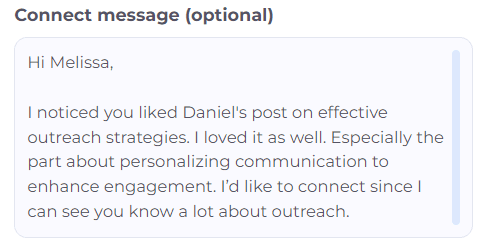
Or you can drop them an InMail such as this one:
Subject line: Post about {{Topic}}
InMail template:
Hi {{firstName}},
I noticed you reacted to {{authorName}}’s post on {{subjectOfThePost}}. I loved it as well — especially the part about {{statementAndConclusion}}.
Anyways, I noticed by looking at your profile that you’re familiar with {{Topic}}, so I wanted to see whether you are approaching {{KeyProblemYou’reSolving}} in {{currentCompany}}?
I would love to know more about this.
Best, {{Your Name}}
Response rate: 35%
Real-life example:
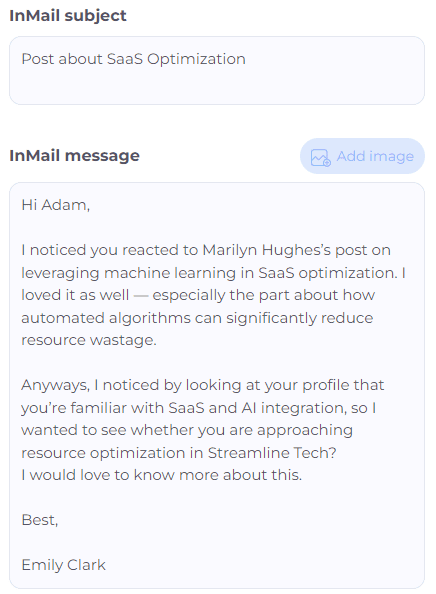
Mention a shared connection
People are more likely to accept a LinkedIn invite if they reference a mutual connection. If you’d like to increase your chances, you can send an invite such as this one:
LinkedIn connection request template:
Hey {{firstName}},
I noticed that {{mutualConnectionName}} is part of your network too. We {{yourHistory}}. Anyways, I see you work as {{Position}} and like to chat. Maybe we can exchange some tips.
Real-life example:
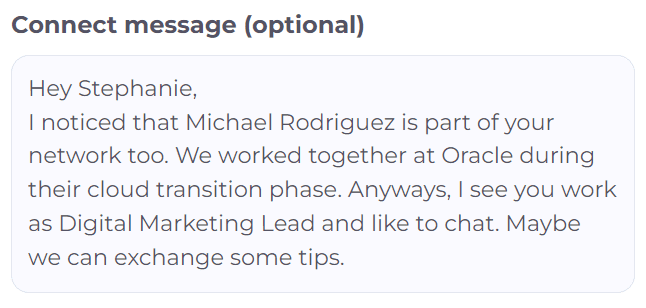
See if a mutual connection can introduce you
If, however, you prefer to get introduced to your lead by a mutual connection, you can send a direct message such as this one:
LinkedIn message template:
Hey {{firstName}},
I noticed that {{leadName}} is a part of your network. I’ve been following them for a while now, and I just wanted to chat about their experience as {{Position}}.
Would you mind if you introduced me to them? It’s always better to be introduced, rather than reaching out of the blue. It would mean the world to me.
Best, {{Your Name}}
Real-life example:
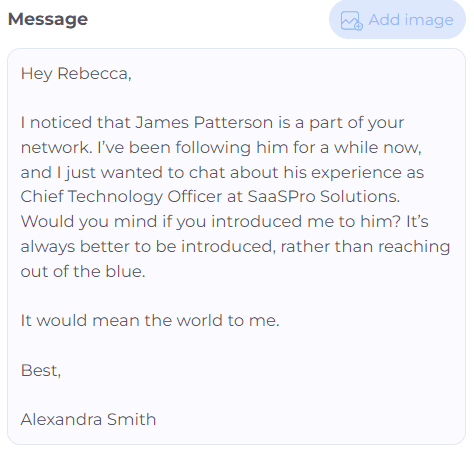
Stroke their ego
Everybody likes when they receive a compliment about their work or accomplishment. So, one way you can compliment your leads is to find the post you genuinely like and reference it in your cold LinkedIn message.
LinkedIn connection request template:
Hey {{firstName}},
I loved your post about {{Topic}}. What I loved the most was {{Statement}}.
Anyways, I wanted to connect and chat about how you as a {{Position}} handle {{painPoint}} in your daily work life.
Real-life example:
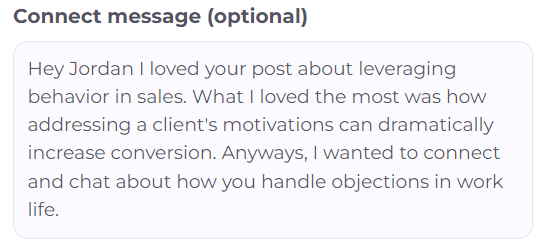
If they do not respond, you can always send an InMail such as this one:
Subject line: Loved your post about {{Topic}}
InMail template: Hey {{firstName}},
I tried sending an invite, but I guess it got lost somewhere along the way. I wanted to reach out and first say I loved the content you are posting, especially the one about {{Topic}}. What I loved the most was {{Statement}}.
Anyways, I just wanted to connect and chat about how you, as a {{Position}} handle {{painPoint}} in your daily work life, and I'd like a chance to present a solution that {{solutionToPainPoint}} to the table.
If what I offer sounds compelling to you, please let me know. However, if the timing is off, or this is not in the area of your interest at the moment, I'll be happy to enjoy your future posts on LinkedIn. 🙂
Warm regards, {{Your Name}}
Response rate: 30%
Real-life example:
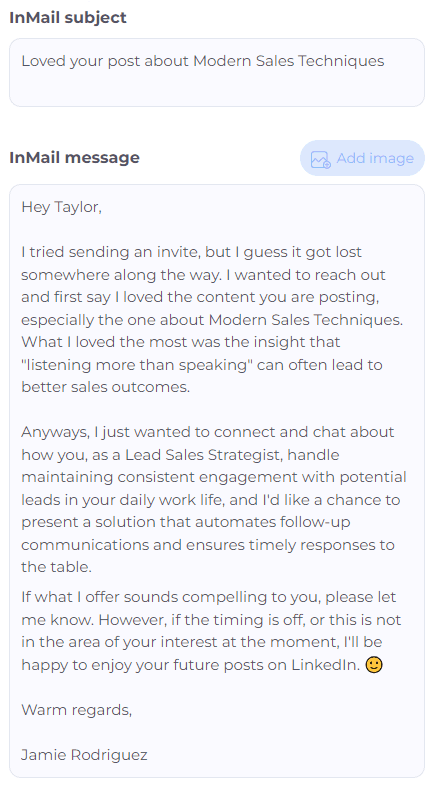
Give reason to reply
By posing a question in your cold LinkedIn outreach, you give them a chance to talk a bit about themselves, and you can learn a bit more about their work. So drop a connection request such as this one:
Cold LinkedIn connection request template:
Hi {{firstName}},
I noticed you work as {{Position}}, so I wanted to reach out and chat about your position. I’m curious what {{Strategy}} has the best {{Result}} from your experience. 😀
Real-life example:
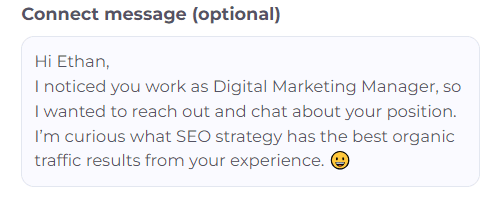
If they do not respond, you can send a cold InMail, such as this one:
Subject line: A quick question
InMail message template:
Hi {{firstName}},
I tried reaching out over a connection request, but it seems it got lost in the sea of requests you might be getting. Anyways, as a {{Position}}, I always like to expand my network and chat with people about their positions. So I came across your amazing profile, and I was curious, what {{Strategy}} has the best {{Result}} from your experience? 😀
Looking forward to hearing from you.
Warm regards, {{Your Name}}
Real-life example:
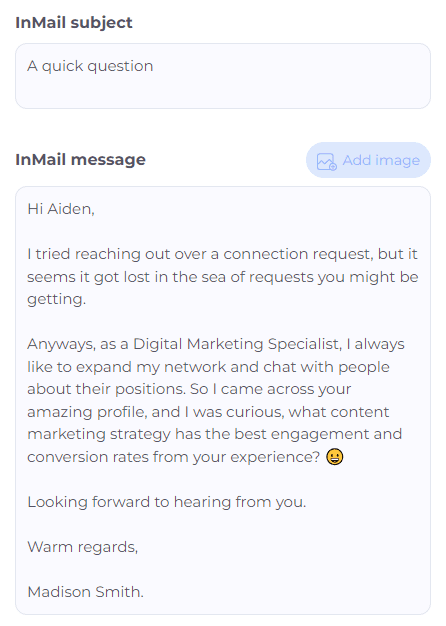
Leverage a group connection
Leveraging a mutual LinkedIn group is one of the best conversation starters in cold outreach. Moreover, you can top it up with humor in your outreach and create a charming first impression. Here is a connection message template that does just that.
Cold LinkedIn connection request template:
Always trust a glue salesperson. They tend to stick to their word…
Just kidding, {{firstName}}. I saw that you are also part of the {{groupName}} group. Hope we can learn from each other!
Acceptance rate: 63%
Real-life example:
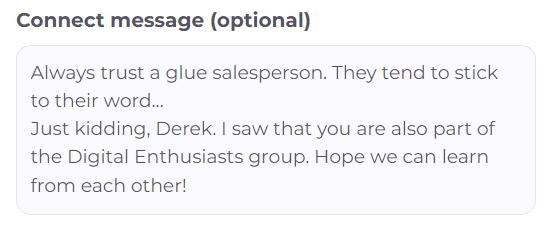
And if they accept a request and do not respond, your next LinkedIn message could sound like this:
LinkedIn message template:
Hi {{firstName}},
Thank you for connecting. I love chatting with other members of the group. Was curious, how are you solving {{painPoint}} at {{currentCompany}}?
Response rate: 37%
Real-life example:
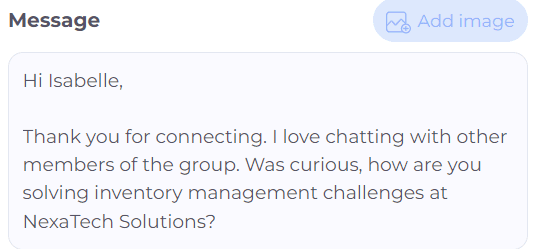
However, if they don't reply to a connection request, you can send the following InMail:
Subject line: Saw you are also a member of {{groupName}}
InMail template: Hello {{firstName}},
I recently tried connecting on CompanyTinder with you... I mean on LinkedIn. Just joking {{firstName}}, I visited your LinkedIn and saw that we are both a part of the same LinkedIn group.
Anyways, I couldn't help but notice you are {{occupation}} at {{currentCompany}}. I was curious, how are you solving {{painPoint}}?
If you still haven't found the solution, I would love to chat with you this week over a call about how {{nameOfYourCompany}} could help you. Either way, hope Q2 is going great for you!
Best! {{Your name}}
Response rate: 27%
Real-life example:
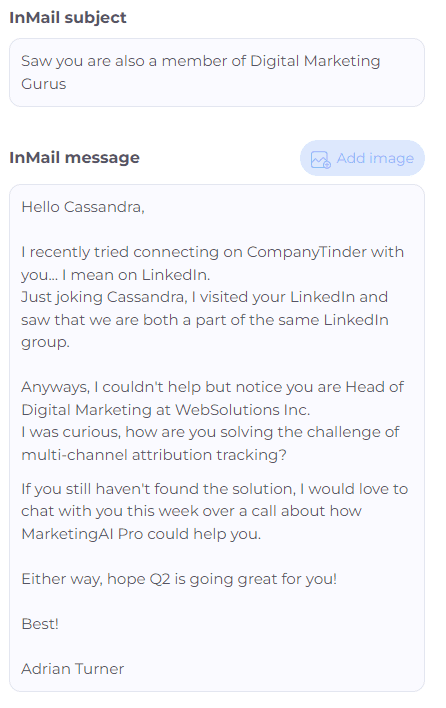
Then you can proceed by asking them what their biggest challenges are, offering tailored solutions, and presenting your product or service.
LinkedIn cold message for B2B lead generation
If they viewed your profile
Sometimes your Buyer Persona will view your profile. In that case, you can send them a connection request such as this one:
LinkedIn connection request template:
Hi {{firstName}},
I saw you viewed my profile on LinkedIn. Let's connect and chat. 😊
Perhaps we discover we can collaborate.
Acceptance rate: 63%
Real-life example:
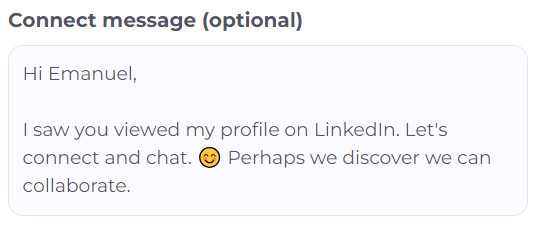
If they accept your connection request but do not respond, try taking this follow-up message for a spin:
LinkedIn message template:
Hey {{firstName}},
Thanks for connecting. Perhaps, I was just in the pool of the {{typeOfProduct}} you are researching. 😊 However, I do have extensive knowledge of {{painPointTopic}}. Let me know if you are looking for something specific.
Response rate: 29%
Real-life example:
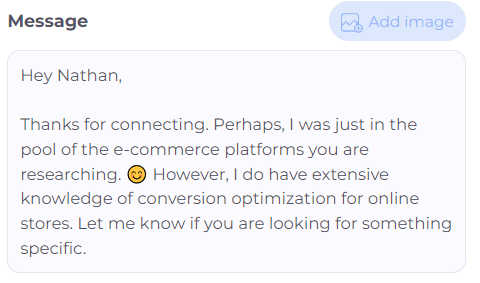
Mention relevant company news
You can also reference recent company news, achievements, or celebrations to catch your lead's attention. In addition, since the company experienced a change, you can present your product/service as a new and refreshing solution on the market. In that case, help yourself with this piece:
LinkedIn connection message:
Hey {{firstName}},
Congrats on {{companyNewsTopic}}. I've been following you for a while now, and this is truly great to hear! I wanted to reach out and chat about an idea that I think your team can benefit from. Let's connect on this.
Real-life example:
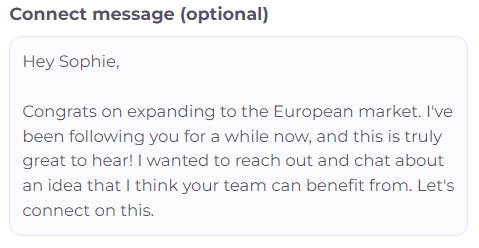
However, if they don’t accept a connection request, send them this InMail:
Subject line: {{ProductOrServiceType}} that actually {{benefit}}! 🙂
InMail message template: Hi {{firstName}},
Congrats on {{companyNewsTopic}}. I’ve been following your company for a while now and I think this is a huge deal! Anyways, It would be silly of me to think you’re not using an {{productOrServiceType}} already, but it’s a no-brainer to present something new on the market that actually helps {{Position}} reach {{Result}} specifically. {{shortDescirptionAboutYourProduct/ServiceWithBenefits}}
Let me know if this sounds interesting to you.
Best, {{Your Name}}
Response rate: 20%
Real-life example:
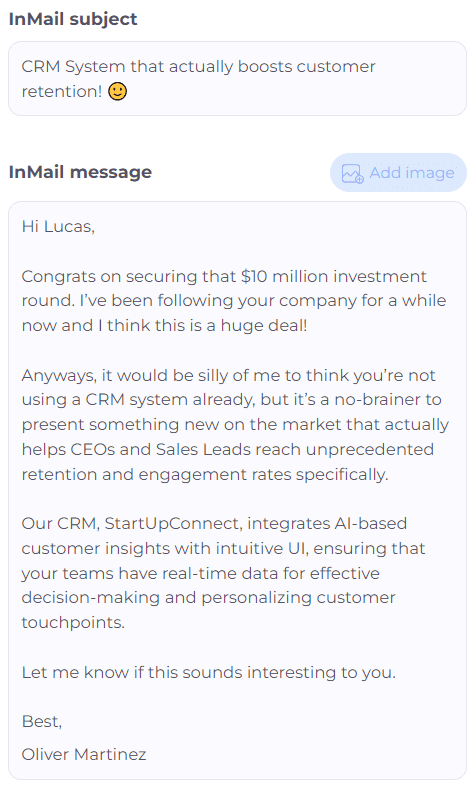
Pitch your product
Some sales professionals want to pitch a product or a service at the beginning of the cold outreach stage. In that case, here are a few sequence templates that will help you achieve very good results.
LinkedIn connection request template:
Hi {{firstName}},
Your profile really caught my attention while I was looking for {{TheTypeofCompanyYouTargeted}} companies. Let’s connect!
Real-life example:
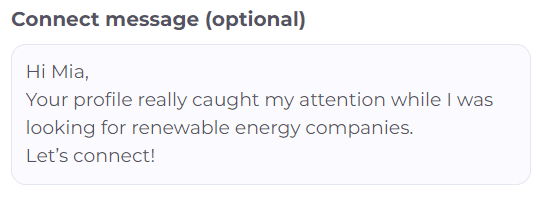
If they accept a connection request, then your following message can sound something like this:
LinkedIn message template:
Hey {{firstName}},
Thanks for connecting! I am looking for companies who are seeking to improve their {{keyProblemYouAreSolving}}
Did you know that you can achieve {{resultsYourProductProvides}}? I believe {{yourProductOrService}} will be an excellent fit for {{currentCompany}} because {{howYourProductOrServiceHelpsYourClients}}. If this sounds interesting, let’s have a chat! How’s next week?
Real-life example:
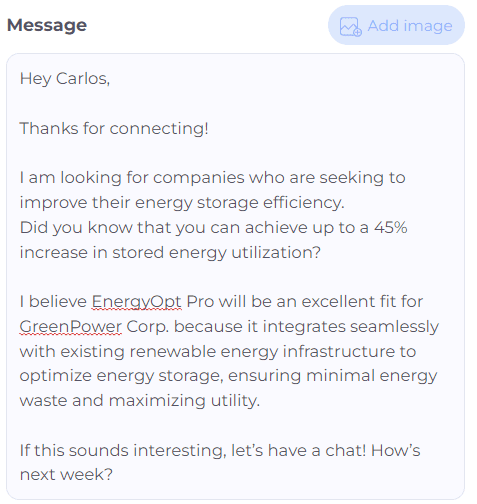
However, if they do not accept a connection request, send an InMail with the following call to action:
Subject line: Quick question about {{currentCompany}}
InMail message template:
Hi {{firstName}},
I am looking for companies seeking to improve their {{keyProblemYouAreSolving}}, and your profile caught my attention.
Did you know that you can achieve {{resultsYourProductProvides}}? I believe {{YourProductOrService}} will be an excellent fit for {{currentCompany}} because {{HowYourProductOrServiceHelpsYourClients}}.
If you agree, let’s connect and have a chat! What do you think about next week?
Best, {{Your Name}}
Real-life example:
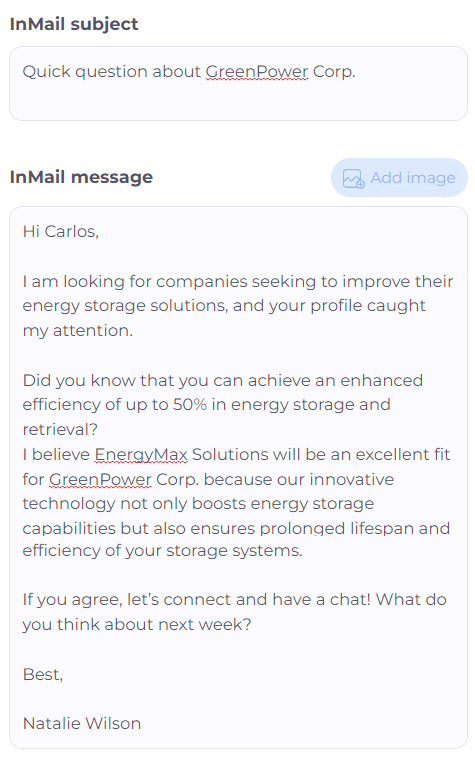
This entire sequence results in:
- Acceptance rate: 67%
- Response rate: 39%
Use past client wins
If you want to pitch first, you can also use some case studies of similar companies. This way, you can demonstrate bullet-proof case studies of your best clients, similar to your leads in question. The following template can work if someone didn’t accept your LinkedIn invite previously.
Subject line: Swift question - not to shake it off 🙂
InMail message template:
Hi {{firstName}},
I tried reaching you through LinkedIn, but I guess your account is also overwhelmed with connection requests, ha?
Anyway, the reason I decided to contact you is that I noticed that you work as a {{Position}} at {{currentCompany}}.
We actually were able to help {{RelevantCompany/CaseStudy}} with {{KeyProblemYou’reSolving}}, so I was wondering how you are approaching it at your company.
Worth a convo?
Kind regards, {{Your name}}
Response rate: 35%
Real-life example:
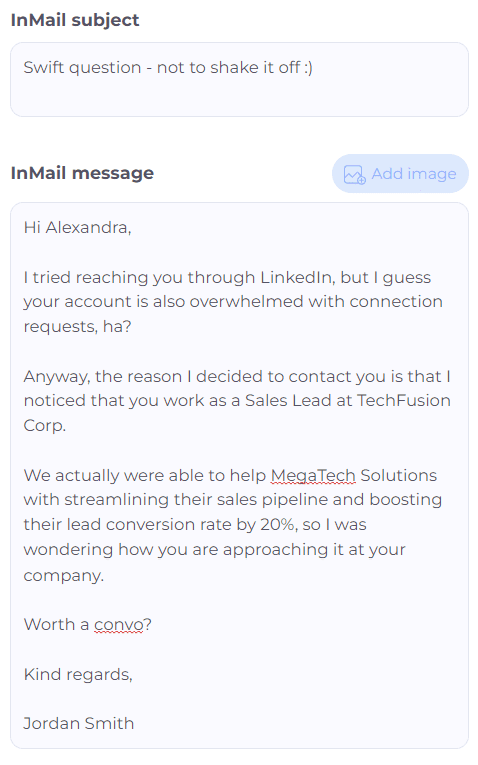
Refer to an event or webinar where you both participated
One of the best LinkedIn cold messages that point out common ground is the one that references a webinar or an event you both attended. Here is how your connection message can sound like:
LinkedIn connection request template:
Hi {{firstName}},
I see you are interested in attending the same webinar as I am. I am talking about {{[nameOfTheWebinar}}. I’d like to connect with you and discuss the event topic.
Acceptance: 75%
Real-life example:
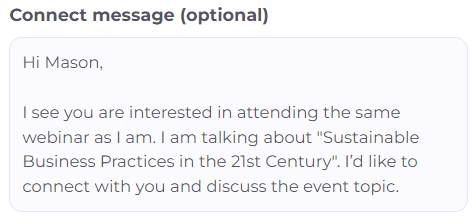
After your leads accept a connection request, you can continue the conversation by using the following LinkedIn cold message template and pitch accordingly later on:
LinkedIn message template:
Thanks for connecting with me, {{firstName}}! So what are you looking to get from this event?
However, if the lead doesn’t respond to your connection request, you can send an InMail that goes like this:
Subject line: Let’s chat about upcoming {{[NameOfTheEvent}}
InMail message template:
Hi {{firstName}},
I hope you don’t mind reaching out directly to your inbox.
I see you are interested in attending the same event as I am - {{[NameOfTheEvent}}.
Maybe you just overlooked the invitation without realizing it, but if that’s not the case, I’d like to connect with you and pick your brain about this interesting upcoming event.
Best regards, {{[Your name}}
Response rate: 47%
Real-life example:
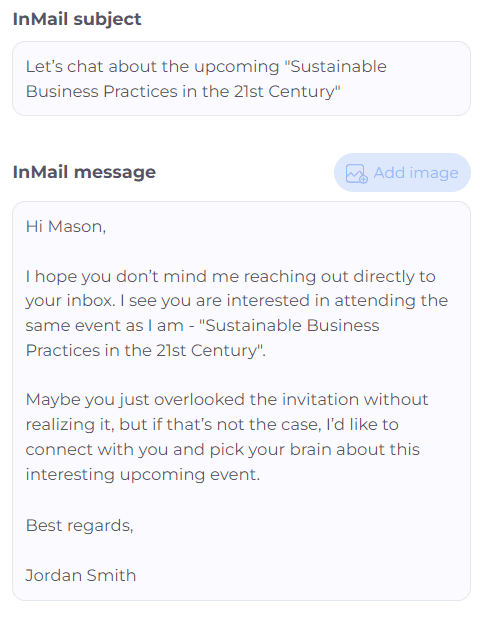
Investor outreach
If you are a startup looking for an investor, your cold LinkedIn message should have a strong CTA. In addition, investors are decision-makers who don’t like to spend time on getting the relevant data from you. Instead, you should present it yourself and show the prognosis of ROI right away.
That said, you can try out this InMail message example:
Subject line: Invest in our company, and get {{Percentage}} ROI in the first year
InMail message template:
Hi {{firstName}},
I am the founder of {{companyName}}, a company determined to help {{targetAudience}} achieve {{Results}}.
I’ve been following you for a while and noticed you’ve invested in a type of company such as ours. I’ve created a detailed report and estimated that you could earn {{amountOfMoney}} within the first year, with an investment of {{amountOfMoney}} that will cover our 6-month period.
If this interests you, I would love to show you a detailed report and all the calculations over a call.
Best regards, {{Your name}}
Real-life example:
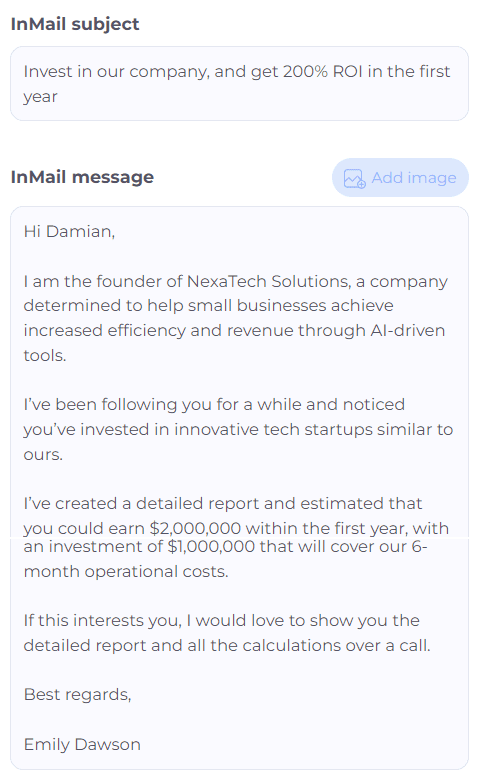
LinkedIn cold message templates for recruiter
If you work as a recruiter in a startup this would be a perfect cold InMail message example for you.
Subject line: Are you our next {{companyName}} star?
InMail message template:
Hi {{firstName}},
We are {{companyName}}, a team of young people who {{whatYourCompanyDoes}}.
Currently, we are looking for an ambitious person, desirably with the {{Position}} experience and aspirations to grow and develop their career path.
Our team is very successful and fast-developing, and we have multiple sectors where you can further learn and develop your career path. We strive to encourage people who come to our company to contribute with their suggestions and propositions to improve their sector and, thus, the company as a whole.
Would you be interested in working in such a young and dynamic team? 🙂
Best, {{Your name}}
Response rate: 65%
Real-life example:
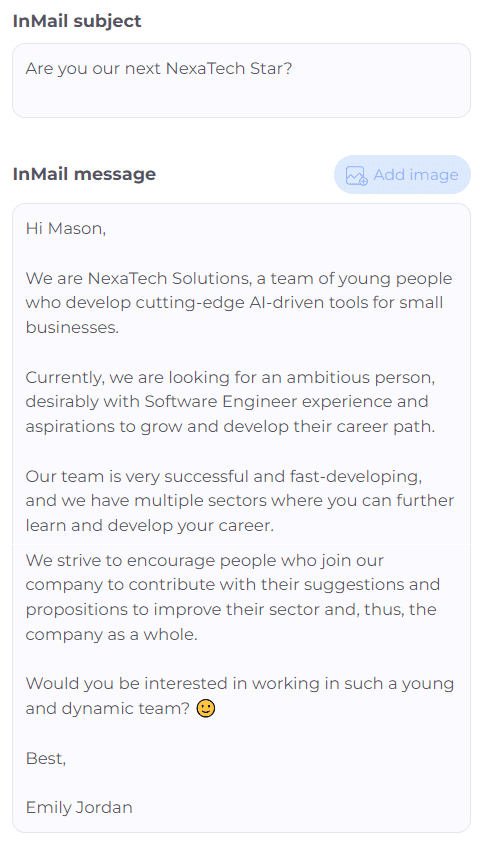
And here is a LinkedIn cold message template for a connection request:
LinkedIn connection request template:
Hey {{firstName}},
I’m HR at {{companyName}}, a team of young people who {{whatYourCompanyDoes}}. We are searching for an ambitious person to fill in our {{Position}} vacancy and aspirations to grow and develop their career.
Real-life example:
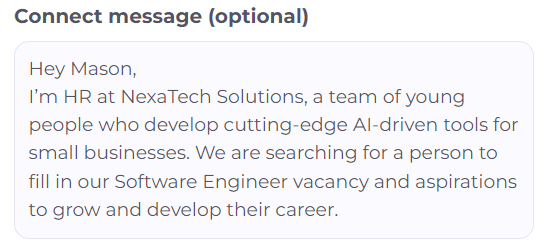
LinkedIn message examples for job seekers
Messaging a recruiter directly
If you see a hiring manager publishing a job post on LinkedIn, in most cases, it is good to send a connection request to HR. To clarify, this will show that you are serious, proactive, and demonstrate initiative.
Cold LinkedIn connection request template:
Hi {{firstName}},
I’ve noticed you published {{Position}} job post. I’ve been following {{companyName}}, and it’s my dream workplace. So I thought it would be better to send you a message, connect directly and show you my passion for this role.
Real-life example:
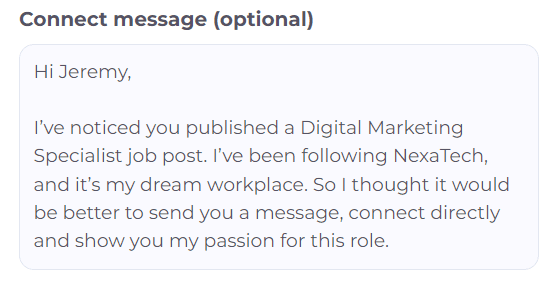
Cold messaging an employee
This is one of the ways to figure out what the company culture is like and establish a connection with an employee within your desired company.
LinkedIn connection request:
Hey {{firstName}},
I noticed you work at {{currentCompany}}. How has your experience been in the {{Department}} since you started? I'm searching for job opportunities, and {{currentCompany}} is my #1. I’d like to connect to chat about it.
Real-life example:
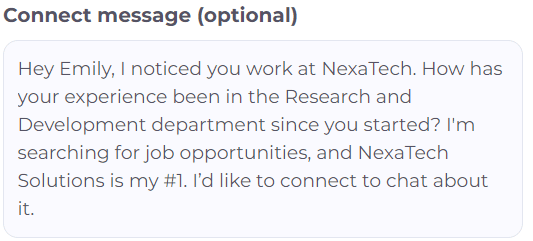
And if they respond, you can send a message such as this one to get their referral:
LinkedIn message template:
Thanks for your message, {{firstName}}.
Really appreciate it. On a side note, are you aware that the {{Position}} job listed on {{websiteName}} falls under your department? If not, can you point me to the person usually responsible for recruiting for such roles? I'm considering applying and would like to ensure my application doesn't disappear in the digital chaos.
Real-life example:
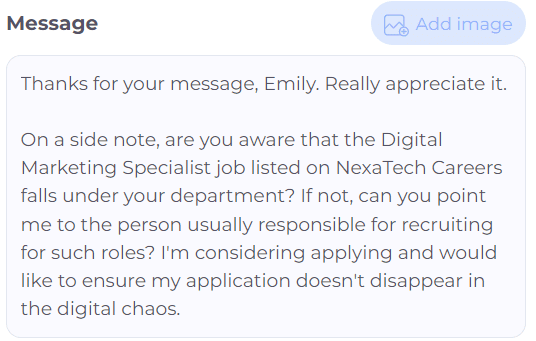
Request an informal interview
Sometimes, in your target company, there are no job vacancies that match your expertise. However, that doesn't stop you from messaging their hiring manager and kindly asking for an informal interview. You can test out this template.
LinkedIn connection request template:
Hi {{firstName}},
I've been following {{currentCompany}} for a while now, and I adore your company culture and achievements. Even though you don't have roles matching my skills, I'd still like to connect and schedule an informal call and present myself in person.
Real-life example:
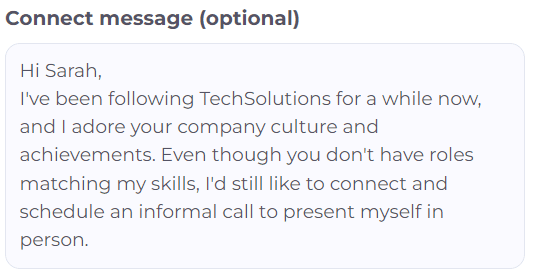
How to cold message on LinkedIn and get replies
Before sending your first message or LinkedIn connection request to your potential customers, you need to get your outreach strategy straight. This way, you can prepare the ground to generate higher-qualified leads faster. Here are our top tips for doing so.
Optimize your profile
The first rule to get the best out of your LinkedIn cold message is to optimize your LinkedIn profile. People are more prone to accept a connection request from someone whose entire profile is set up. In other words, you have your:
- Profile and cover image,
- LinkedIn headline,
- Company name,
- About section,
- And the education section.
For example, if you are a salesperson, potential customers can check out your LinkedIn profile and see your product/service and what you are all about before accepting a connection request.
On the other hand, if you are a hiring manager, candidates can take a look at your company name and website. Otherwise, if your profile is not entirely set up, they would mistake you as a fraud. Think of it as the first barrier of defense to prove the validity of your outreach strategy.
Target the right people - ICP & buyer persona
Both cold emails and LinkedIn connection requests can go down the drain if they are aimed at the wrong target audience. In other words, you need to research and create your Ideal Customer Profile and Buyer Persona. Find out what’s your ideal company headcount, revenue, or location. Buyer Persona wise, figure out what position uses your product/service, whether they are decision-makers or not, and their pain points so you can tailor your sales pitch.
If you are a hiring manager, a Persona for each position will be enough. Just make sure to target the correct position, industry, years of experience, and other factors relevant to your job vacancy.
Lastly, the best way to create these two documents is to analyze your current ideal customers. In other words, find the ones with:
- Highest retention rate and LTV;
- Shortest buying cycle;
- And who would be a referral for your product someplace else.
N.B. Remember that every piece of information in your ICP or Buyer Persona documents needs to be actionable. In other words, create a document with the information you can use for your LinkedIn prospecting or messaging purposes.
Find your leads using LinkedIn filters
Our next piece of advice is to learn how to find your ideal leads. If you are a sales executive, get to the bottom of the ins and outs of the LinkedIn Sales Navigator filters and LinkedIn prospecting hacks. Or find leads outside LinkedIn and trace them back to this social media. And if you are a recruiter, research Recruiter search filters.
Remember, the goal is to be as narrow as possible, so you can find your ideal leads with a high-quality status and shorter close cycles.
Personalize your cold message
Personalization wins the conversation. Simple as that. The more personalized approach, the more people will respond to your LinkedIn connection request, InMail, or even a phone call.
That said, fill your cold outreach messages with personalized points to get their attention, such as:
- First and last name,
- Current company,
- Position,
- Mutual connection,
- Case studies or posts they shared,
- Webinar they attended,
- Influencers they follow,
- Or the LinkedIn group they joined.
These are just a few examples of how you can personalize your connection messages or cold emails in general. However, when crafting your first message and even second, you should always have in mind that you need to offer value and make it all about your prospects. In other words, help yourself with the deeper personalization points such as:
- What are the new customers' main goals,
- What are their pain points,
- Post they publish,
- Content they created,
- What type of content do they consume?
These points are the ones that will help you get a higher response rate. If you don’t want to present your sales pitch or mention pain points right away, you can always send them an interesting article to spark their imagination about your service.
Lastly, end your direct messages with a call to action. It can be anything from reading a blog, accepting a LinkedIn connection request, or scheduling an online meeting or a phone call. Nonetheless, try to keep only one call to action per message.
However, if you’re tired of manually personalizing and sending such messages, then use the best LinkedIn automation tool to do it for you. With some automation tools, you can use placeholders/variables such as first name, last name, and company. And with some, you can insert custom variables, but more on that later.
Send your cold message, including InMail
LinkedIn users have not one, but three formats they can use to connect with someone on LinkedIn - connection requests, direct message after invite acceptance, and InMails. These two formats are the main ones for the initial contact with potential customers and candidates.
To clarify, InMails are like cold emails but on LinkedIn. You can write your own subject line and have 8K characters available as opposed to a connection request (300 characters). Moreover, you can send InMails to people outside your professional network only if you have a paid LinkedIn subscription.
Types of InMails & benefits
You can send paid and free InMails. The number of paid InMails you can send depends on your LinkedIn subscription. For example, if you paid for LinkedIn Sales Navigator, you have 50 monthly credits. On the other hand, if you paid for Recruiter lite, you get 30 InMail credits and 100-150 credits for a Recruiter subscription. Lastly, LinkedIn Premium offers only 15 InMail credits per month.
Contrary to paid InMails, you can send up to 800 free ones, but only to those LinkedIn users who have set their profile to Open profile status.
That said, make sure to leverage InMail format as a part of your outreach strategy because of the 3 reasons:
- You can contact people that are your 2nd and 3rd-degree connection without sending a connection request;
- You have more characters available than in connection requests, so you can focus on pain points and better CTA;
- It's a great alternative if your connection request is pending and you'd like to send a direct message straight to the decision-makers inbox.
Lastly, you can use the LinkedIn automation tool and cold email software, Skylead, to automate sending InMails. Skylead is unique on the market because it allows our users to send both paid and free InMails. Our users often use InMail as the last step in the Smart sequence if the lead has not accepted the invite or there is no email address.
Follow up
Salespeople often perceive follow-up messages as pushy and a thing that can drive your leads away. Therefore, 70% of them do not send any follow-ups. However, a lesser-known fact is that if you send a follow-up, you automatically increase the chance to hear back from your lead by 25%.
However, if you know how to write a follow-up email after no response or LinkedIn message, you can increase these chances even more.
That said, our advice is to research how to write the best follow-ups out there and never miss to send them. And here is a short, and according to our experience the main advice for the follow ups. Depending on the format, a follow-up should be short and focus on at least 2 of the following:
- Catchy subject line;
- Context;
- Value (case studies, solution to pain points);
- CTA.
Thus, here is one follow-up message that is led by the above mentioned points.
Subject line: Any thoughts?
Follow-up InMail template:
Hey {{firstName}},
Just checking in to see if you got any thoughts on exploring what {{nameOfYourCompany}} could do for {{theirCompany}}?
We worked with Companies similar to yours, such as:
- {{Company1}}
- {{Company2}}
- {{Company3}}
If you give me a chance for a call to show you, just this once, how other {{ProspectsPosition}} have used this solution to {{smallBenefit}}, I promise we can part ways if you are not impressed. Just let me know when is the best time for you. Anyway, love what you are doing with {{theirCompany}}.
Best, {{Your name}}
Response rate: 27%
Real-life example:
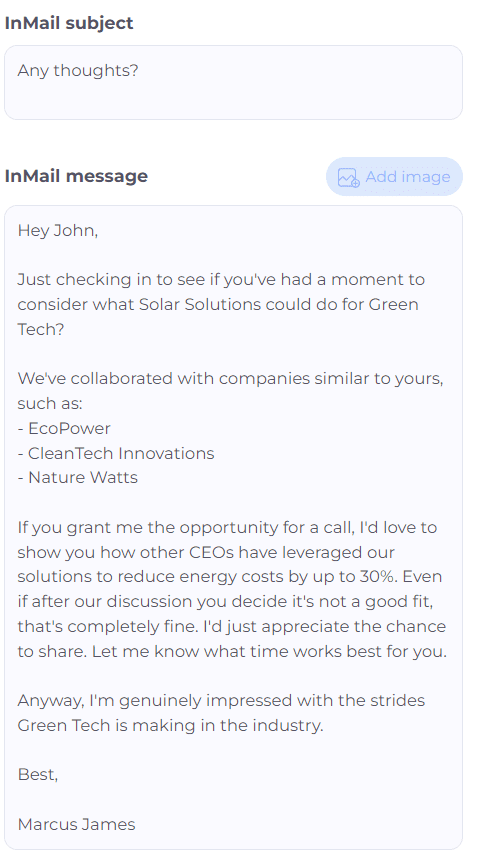
Scale through automation
If you want to accelerate the process and save time on manual outreach, you should automate lead generation on LinkedIn.
Take our very own Skylead, for example. This automation tool helps startup and founders, sales teams, recruiters, marketers, and alike streamline email and LinkedIn outreach tasks, such as sending:
- cold emails,
- connection requests,
- InMails,
- and LinkedIn direct messages,
depending on your leads' behavior. To show you how Skylead follows leads' behavior, let's go through creating one of the outreach campaigns in Skylead.
LinkedIn cold outreach campaign
First, choose your lead source, aka where Skylead will pull the leads from, and insert the source. For the sake of this article, we will select the LinkedIn search result. Don't forget to choose the type of connection, if available.
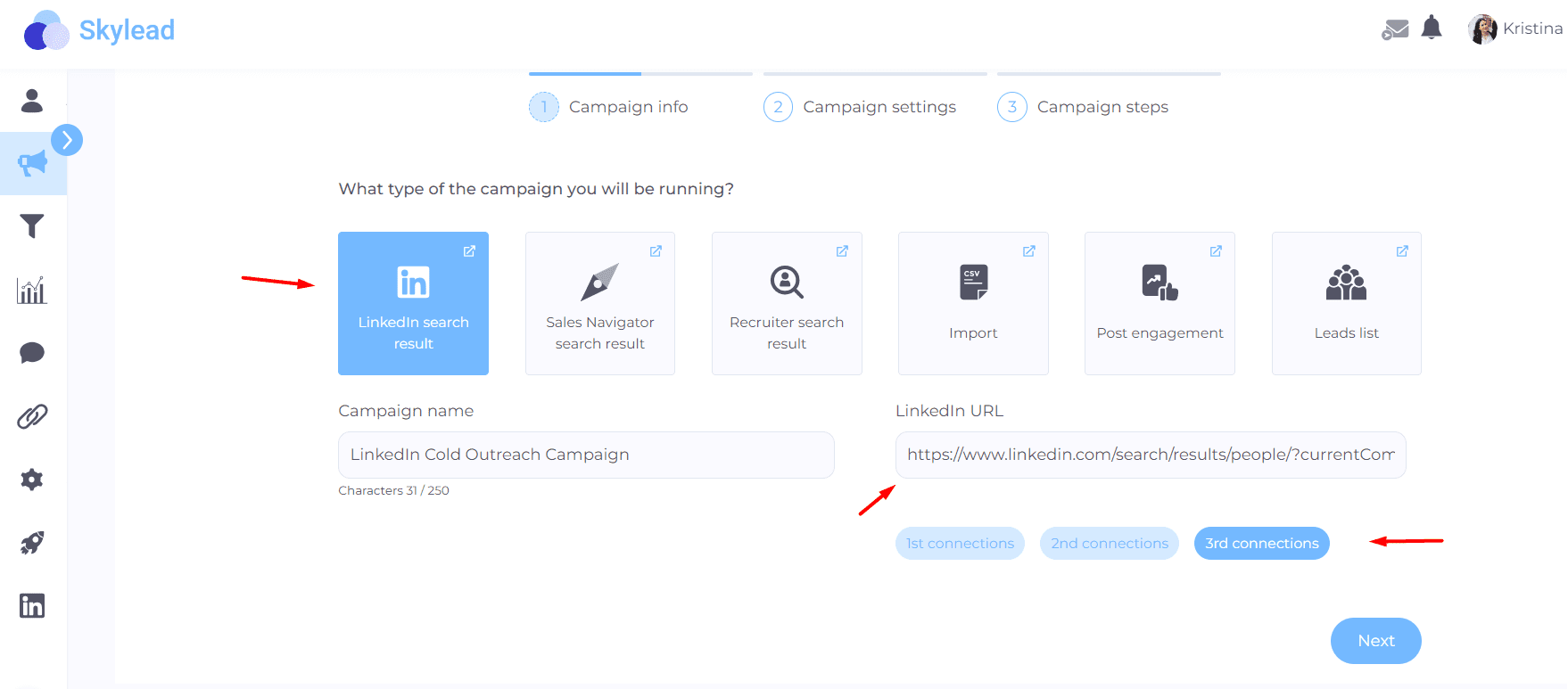
Secondly, set up your campaign settings. Here is where you can determine your launch date, whether you wish to collect contact information or reach out only to those with Premium LinkedIn profiles.
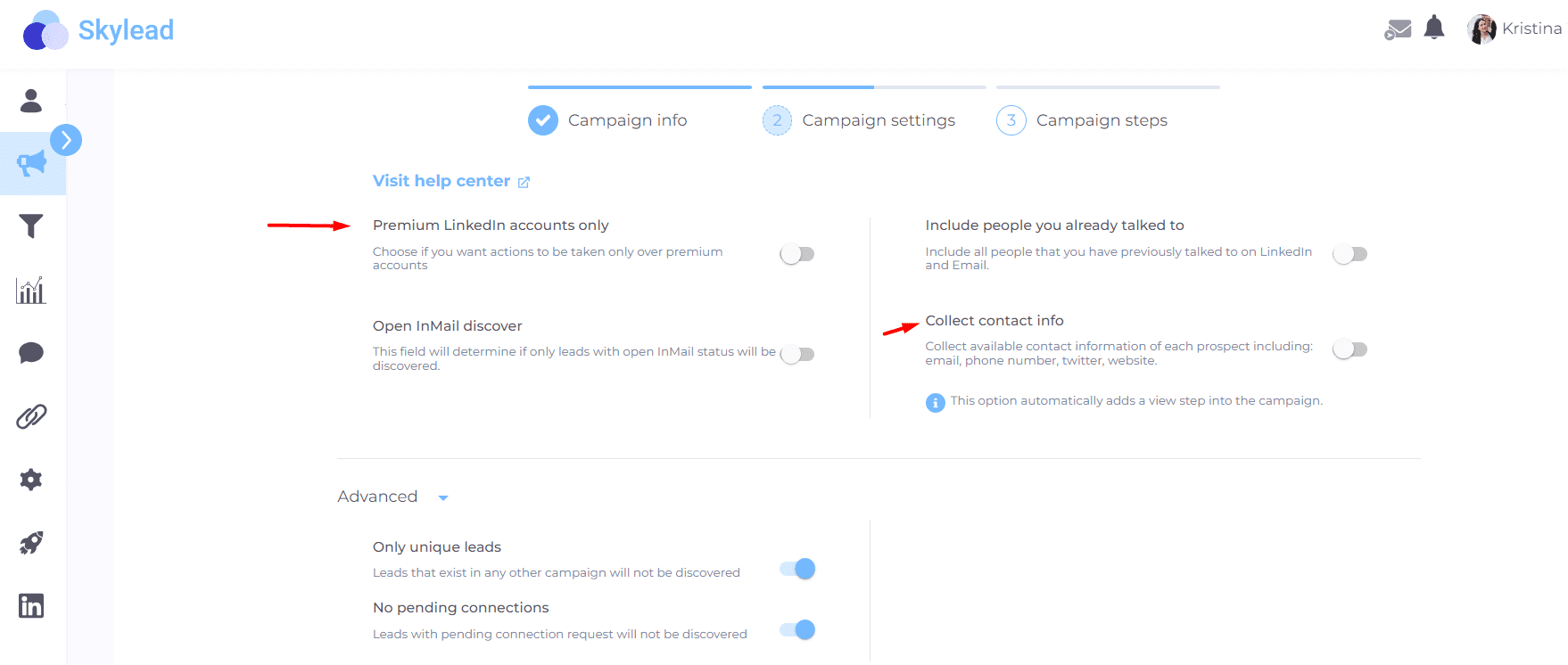
Now, this is where the fun begins. Meet our Smart Sequence, a groundbreaking algorithm that allows you to use multichannel outreach and personalize messages at scale. The secret to why the Smart sequences are so powerful lies in If/else conditions that you can set after each action and let Skylead follow your leads’ behavior and perform actions accordingly.
So, to create a Smart sequence, drag and drop actions and conditions and connect them.
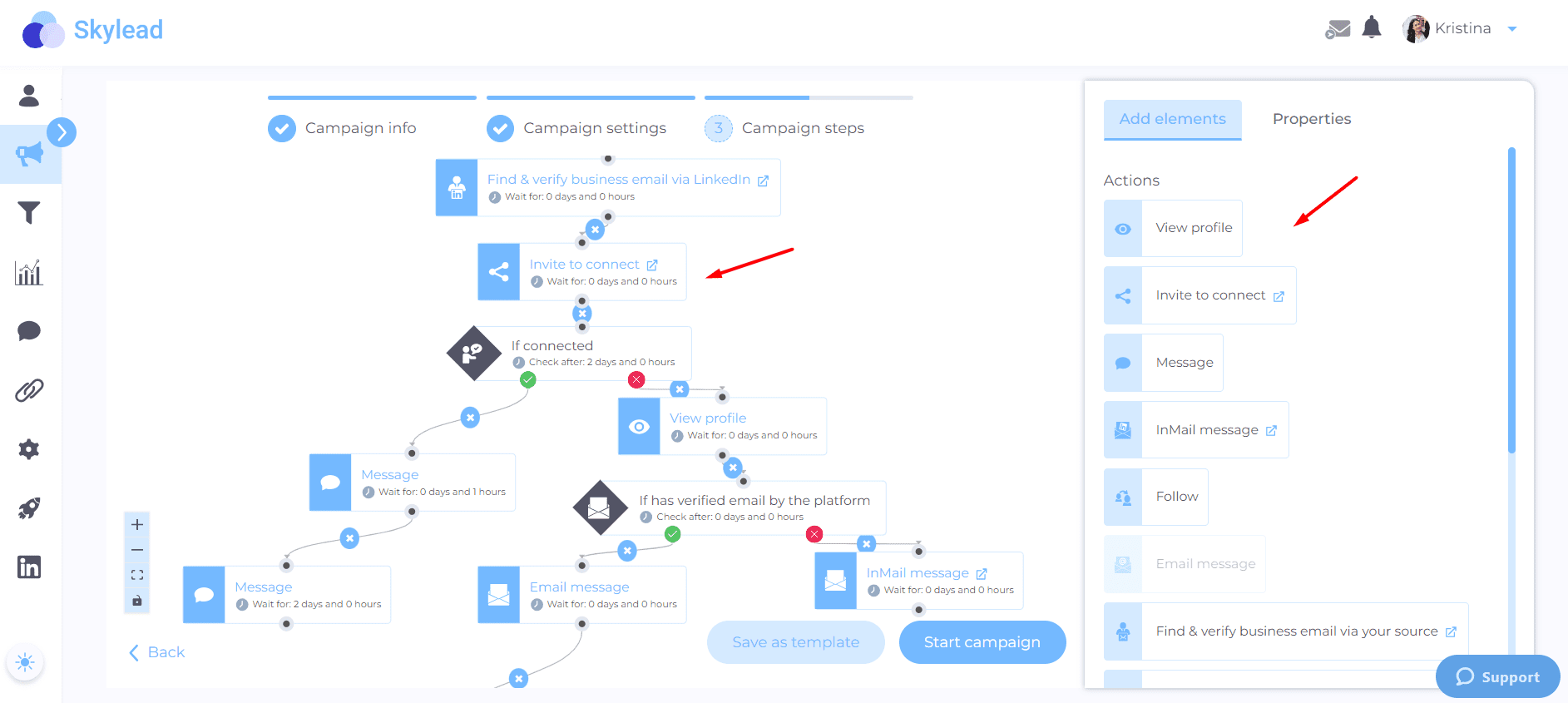
Once you do, write down personalized messages using variables such as first name, company name, and so on. For example, here is how your LinkedIn cold message, aka connection request, can look like:
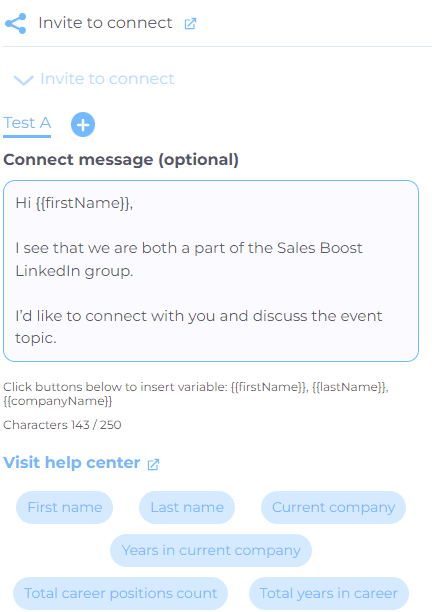
Keep in mind that if you want to personalize your messaging even more, you can always create a CSV file with custom variables and upload it as the lead source.
Moreover, once a lead responds to your message, the sequence will stop for that lead, and you can see all the messages from all the platforms collected and available in our Smart Inbox. This way, you can continue the conversation without navigating between the platforms. What’s better, you can even label the leads with tags and calculate how many leads converted during this campaign.
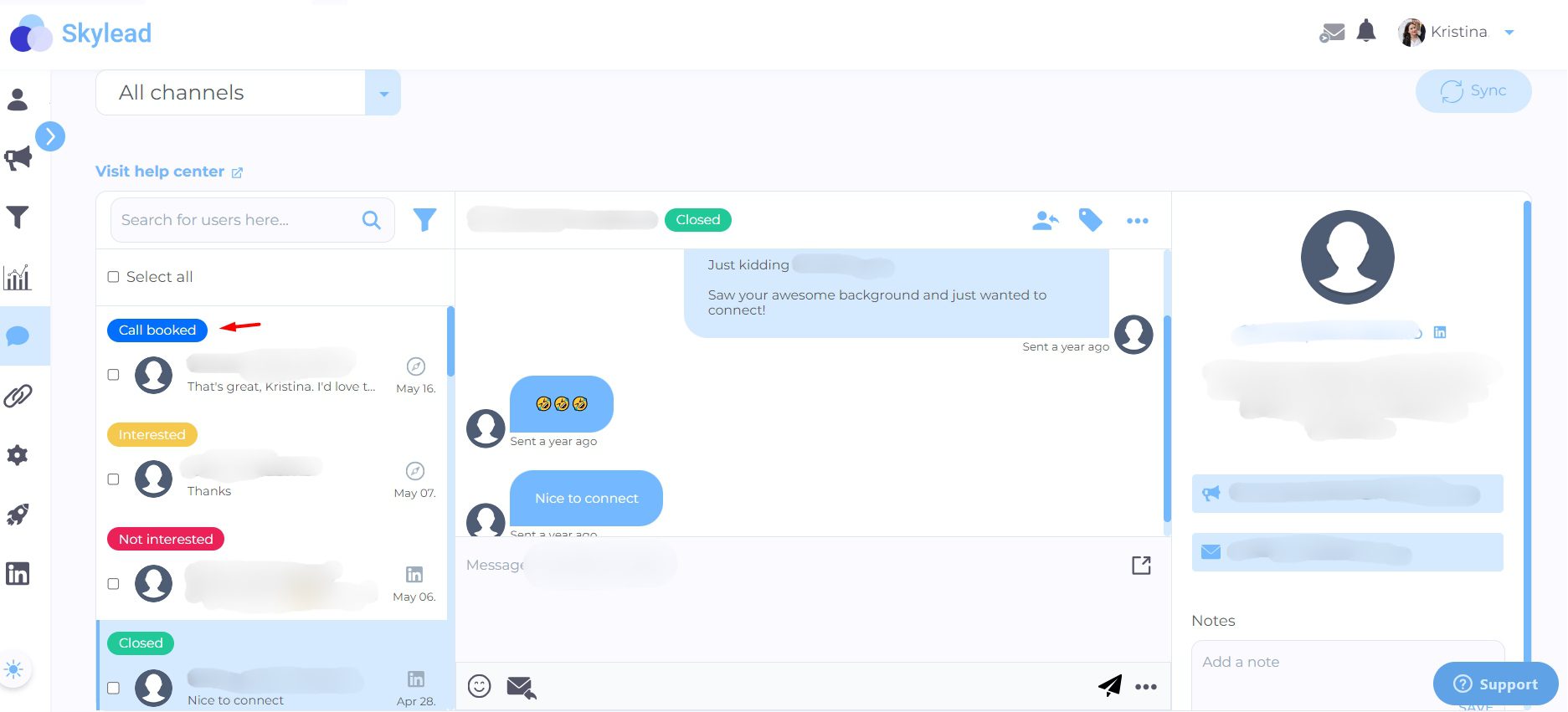
And that is the magic of Skylead. 😊
Frequently asked questions
1. How do these cold message strategies vary in effectiveness across different regions or cultures?
Cold message strategies' effectiveness can vary significantly across different regions or cultures due to varying communication norms and expectations. Tailoring your approach to reflect an understanding of cultural nuances and preferences in communication can greatly enhance receptivity and engagement.
2. What are the long-term follow-up strategies if the initial cold messages receive positive responses?
Long-term follow-up strategies should focus on building a genuine relationship with the recipient. This involves regularly sharing relevant content, updates, and opportunities that add value, maintaining a balance between staying in touch and respecting the recipient's space and interest level.
3. Are there any case studies or success stories of businesses that have significantly benefited from using these specific LinkedIn cold message templates?
Yes. We have a vast library of outreach templates that use these messages, and by examining each type of outreach sequence, you can see other results in addition to the response rate we've stated here.
4. Is it better to cold email or cold message on LinkedIn?
Cold emails have an average of 3% reply rate, while InMail’s is 18-25%. So, cold messages on LinkedIn are better. But it also depends on your target audience and their preferred channel. So, to maximize getting in touch with every lead possible, you should reach out using both channels.
5. What is a good first message on LinkedIn?
“Hey {{firstName}}, I loved your post about {{Topic}}, so I wanted to connect and chat.” Or you can use a humorous approach with personalization: “What’s a marketer’s favorite drink? Brand-y. Just kidding, {{firstName}}, saw that you are also part of the {{GroupName}} group. Hope we can learn from each other!”
Ready for your best cold outreach yet?
So, what are you waiting for? All these messages are ready to use and are waiting on you. However, if you want to write your take on them, we understand - feel free to edit them as much as you’d like. Or, if you wish to use another version of this message, you can always use Chat GPT for sales to write prompts and have alternatives to these LinkedIn cold messages in no time. Either way, you will win this cold outreach game.
And if you’re up for scaling your email and LinkedIn lead generation and automating the process, start our Free Trial and experience firsthand how fast you can scale your business.
A well-crafted LinkedIn connection message can make a busy decision-maker click Accept to yours and leave pending the other 50+ connection requests they received that day on the platform.
With over 65 million decision-makers, LinkedIn is THE #1 professional social network that made it possible for the entire world to connect business-wise.
However, while it’s true that, today, you can find anyone you need on the platform, the volume of messages certain professionals get on a daily basis is so high that you need to find a way to stand out from the crowd to get their attention.
To understand how important connections are on LinkedIn, bear in mind that 98% of sales representatives with more than 5,000 LinkedIn connections mostly surpass their selling quotas.
The maximum size of your network on LinkedIn is limited to 30,000 connections, so you want to use that number to connect with LinkedIn members relevant to your business (and you want to do so before your competitors, so… ⬇️ )
In this blog, we will:
- Answer some of the most common questions about LinkedIn connection requests;
- And give 25 proven LinkedIn connection message examples with up to a 78% acceptance rate to use right away.
How to send a connection request on LinkedIn?
To connect with a LinkedIn member from the search result, click on the Connect button in the top right corner of the member’s LinkedIn profile section.
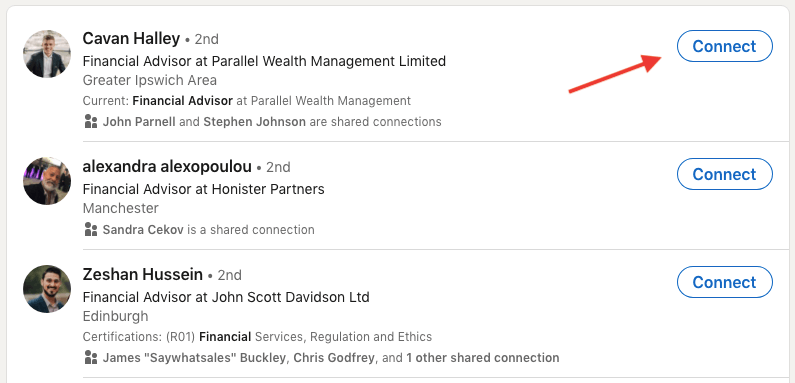
OR
Open the LinkedIn member’s profile. Click Connect.
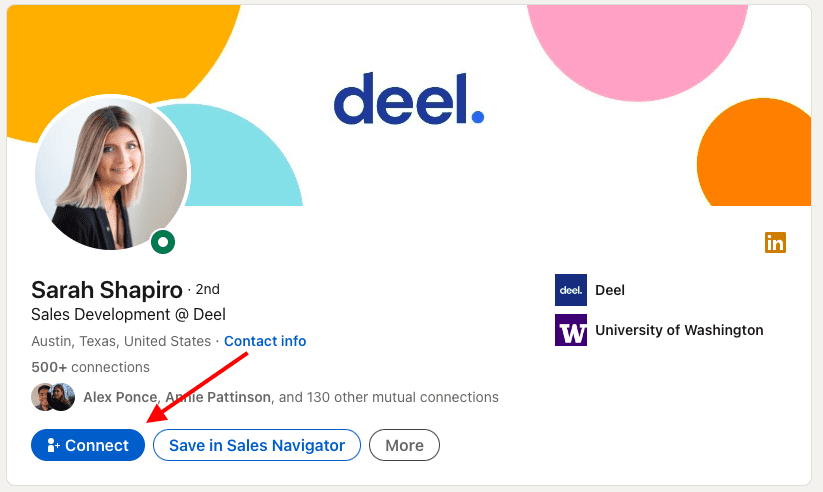
How to cancel a pending LinkedIn connection request?
Not a lot of people monitor their pending LinkedIn connection requests, which is wrong because the integrity of their LinkedIn profile could get damaged. Essentially, good pending-request hygiene can save you from LinkedIn jail and improve your acceptance rate on the platform.
That’s why, we wrote a complete guide on How to cancel your LinkedIn invite, and, above all, explained in detail:
- Why do you need to cancel your LinkedIn invite;
- What you need to know about the cancellation process;
- How to cancel LinkedIn invitations that are pending for a long time;
- Why your LinkedIn invites aren’t getting accepted;
- How to create engaging invitations that will increase your acceptance rate.
Skylead users have the benefit that you can set up Skylead to withdraw pending requests to safeguard their LinkedIn profiles and allow them to send invites to connect to other people relevant to their business.
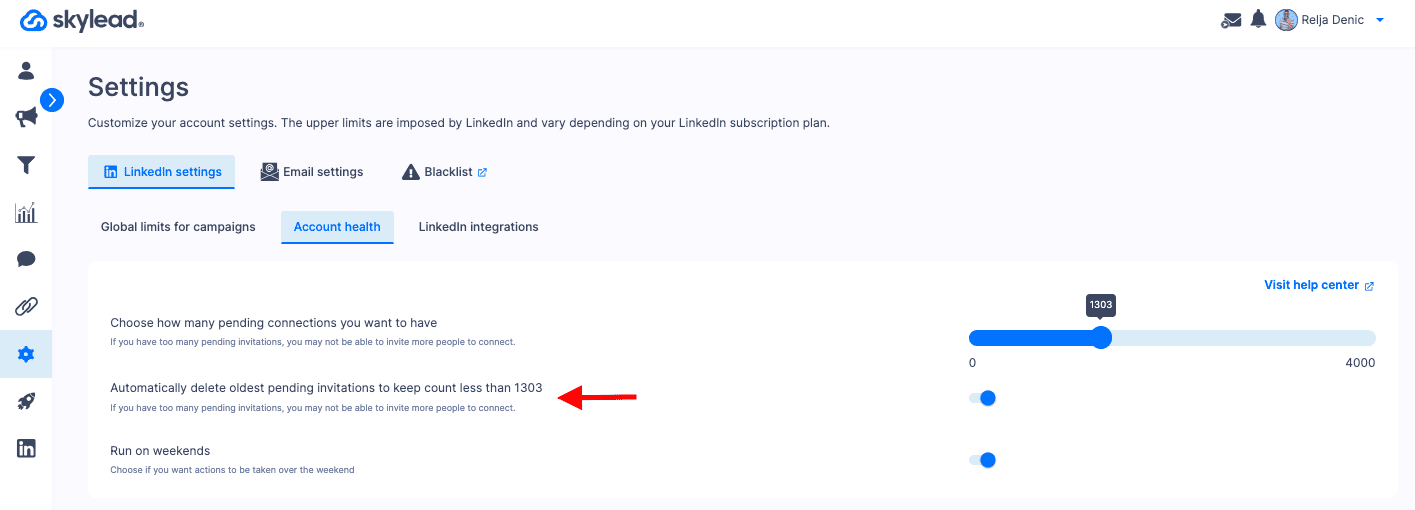
In the meantime, if you just wish to cancel a pending LinkedIn connection request, first click My Network on your LinkedIn profile home page.

Choose Manage or See all.

Choose Sent and the Withdraw option that’s next to the LinkedIn member’s name.
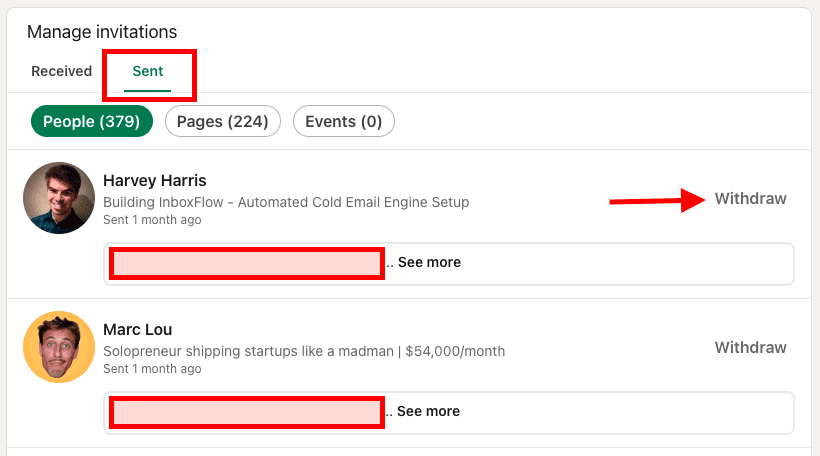
If you cancel a LinkedIn connection request, you won’t be able to send it again to the same member for the following 3 weeks.
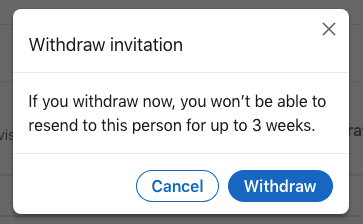
How to message someone on LinkedIn who is not a connection?
There are 3 types of connections on LinkedIn, and here is how to message every one of them.
- 1st-degree connections are LinkedIn users who are already part of your network. Reach out to them via regular LinkedIn messages using some of these LinkedIn sales message templates.
- 2nd-degree connections are LinkedIn members who are connected with your 1st-degree connections but not with you. Send them a LinkedIn connection message first, followed by a Thank you message on LinkedIn once they accept.
- 3rd-degree connections are LinkedIn members connected with your 2nd-degree connections. The platform encourages to reach out to these members via LinkedIn InMail first ( ➡️ here are LinkedIn InMail templates with a 25% reply rate formula tested by our Head of Sales, Andrea)
How to write a connection message on LinkedIn [5 best practices]
So, as mentioned above, it takes only a few people to deny your LinkedIn connection request and click I don’t know this person for you to be flagged on LinkedIn.
So, we decided to share 5 guidelines followed by our sales team when writing a LinkedIn connection message.
Look for common ground.
Mentioning any common ground turned out to be a positive practice. It could be a community you both belong to, a shared interest, a school, an industry, or even the same point of view on a specific topic.
Stay professional.
Reach out to other members in a professional manner. Avoid making personal references or giving compliments that are not business-related or argued.
Personalize your LinkedIn connection messages.
Addressing your lead by name is a must. Then, any other detail that you can mention, such as - the company name, the exact job title, set of skills, or job description, shows that you did your research. The more you know about your lead, the higher the chances of getting accepted on LinkedIn and turning that lead into your customer.
No generic nor irrelevant LinkedIn connection messages.
Even a blank LinkedIn connection request is better than I’d like to add you to my network.
Also, it’s hard for a pharmaceutical sales representative to be interested to read your article on SEO. Know who you are talking to.
Avoid selling straight out the gate.
Even if they need and like your product or service, no one will purchase anything without any additional info, chat, or call.
25 LinkedIn connection message examples [Up to 78% acceptance rate]
Tailor-making a LinkedIn connection message to each lead might seem a bit time-consuming, but it doesn’t have to be (not if you’re using Skyleaaaad 😂 ).
Jokes aside (or not!), the results of sending personalized LinkedIn connection messages are pretty rewarding.
Once you get used to the principles of writing in a compelling, LinkedIn-friendly way, your LinkedIn outreach will become a much more enjoyable experience.
Until then, use the LinkedIn connection message examples below that our team and users tested to grow their networks with relevant prospects.
Mention a mutual connection
Template
Hello {{firstName}},
I noticed that you are connected with {{mutualConnection}}.
{{mutualConnection}} and I worked together at {{company}}. I really loved {{whatYouLovedAboutMutualConnection}}.
I see that we are both in the {{industry}} industry and would love to have you in my network.
Example
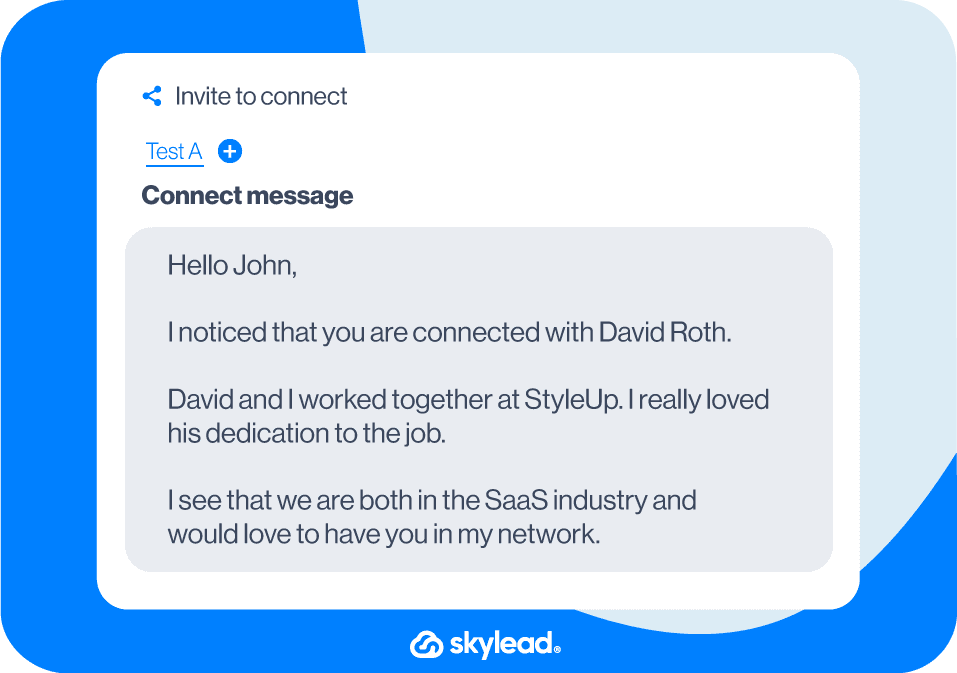
OR
Template
Hello {{firstName}},
{{mutualConnection}} pointed me your way for B2B lead generation services – would love to connect.
Example
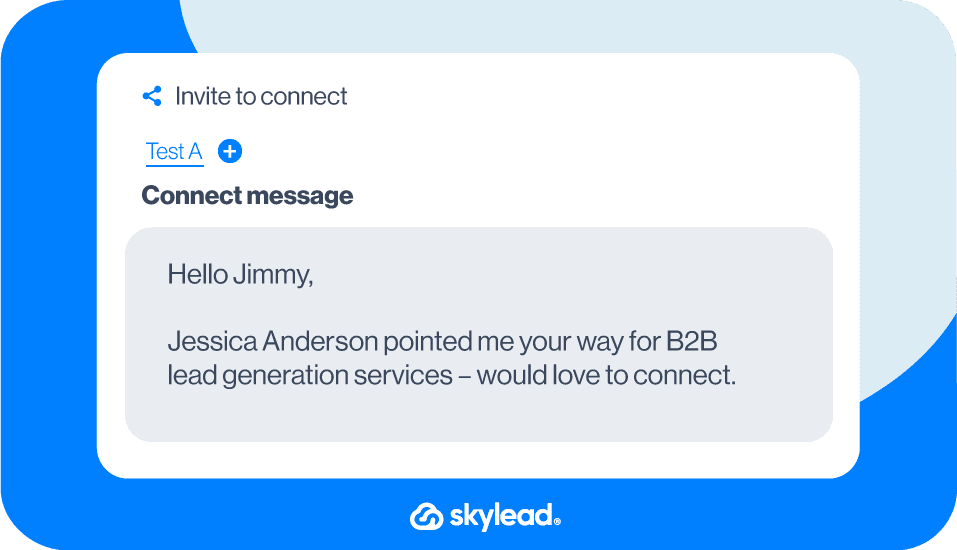
Reaching out to a candidate (as a recruiter)
Template
Hello {{firstName}},
It seems that you’ve been a great addition to your team at {{company}}. Way to go!
I would like to talk to you about a business opportunity.
But even if you’re not interested, it would be great to have you as part of my network!
Example
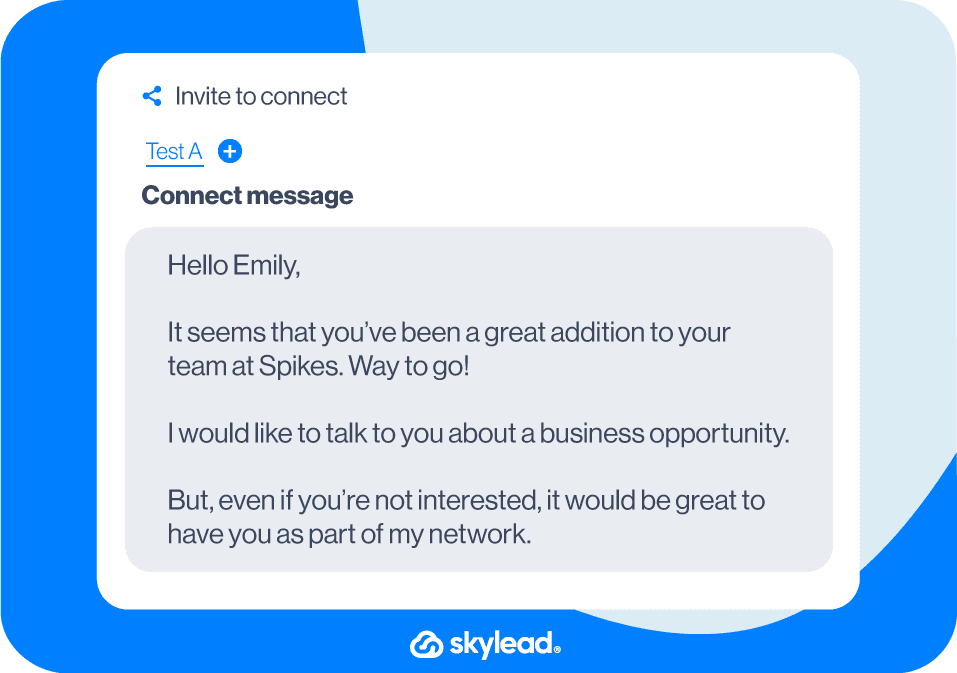
OR
Template
Hello {{firstName}},
I am reaching out to you for your vast experience as a {{occupation}}.
{{company}} is currently searching for a {{position}}.
If this sounds interesting to you, let’s connect.
Example
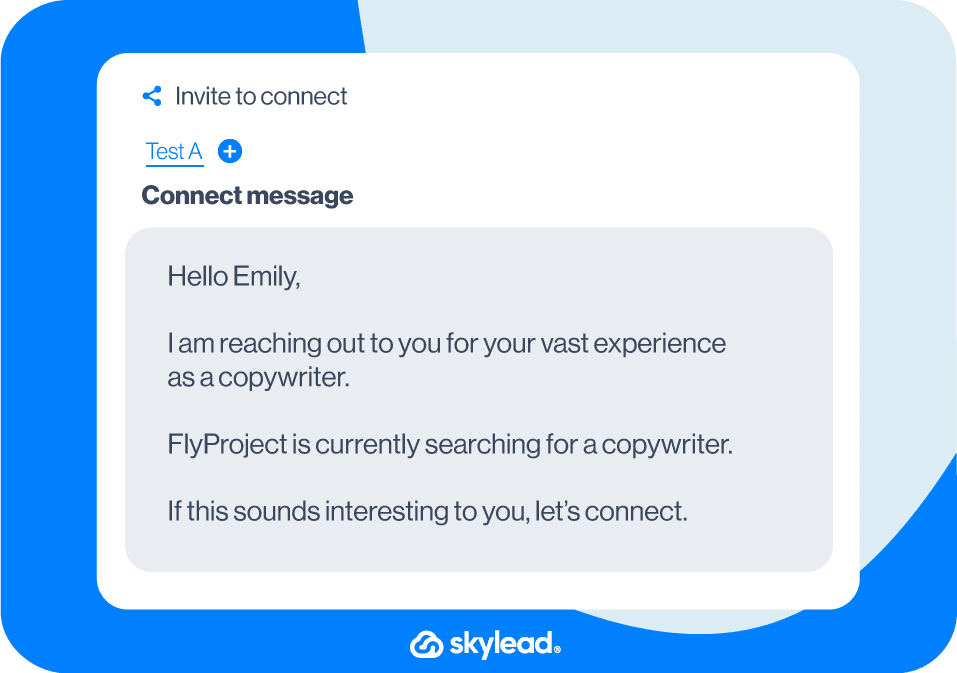
Reaching out to a recruiter (as a job seeker)
Template
Hello {{firstName}},
I saw that you are a recruiter at {{company}}.
I am a {{occupation}} with {{number}} years of experience in the {{industry}} industry, currently seeking new opportunities.
I’d like to connect and chat to see if my background fits any of your openings.
Example
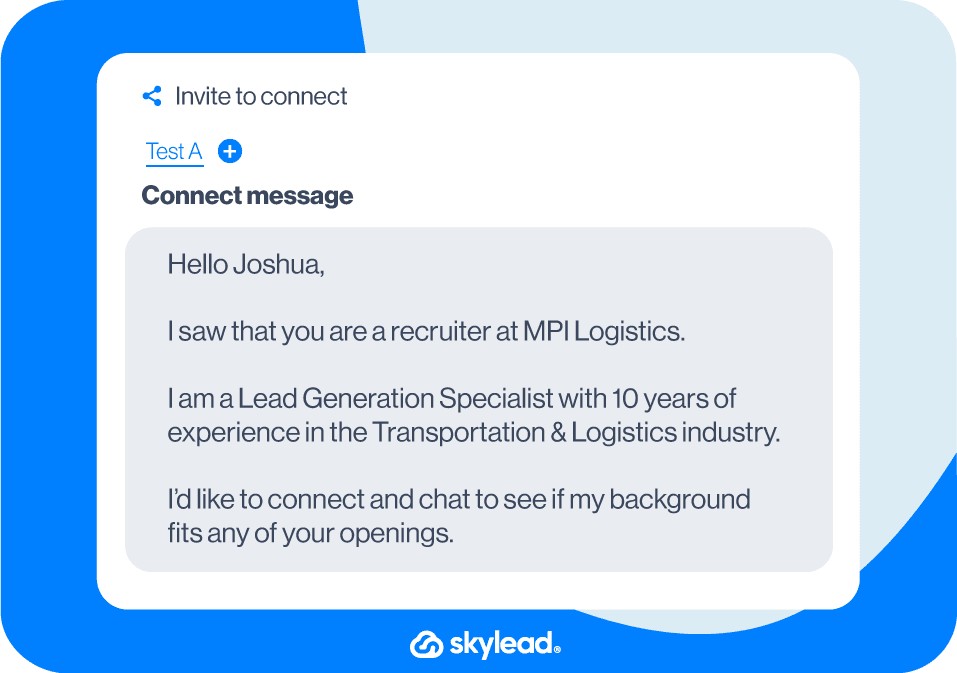
OR
Template
Hello {{firstName}},
I see that you’re the recruiter in charge of the {{occupation}} position at {{company}}.
I am very interested in applying but would like to ask you a few questions first.
Let’s connect.
Example
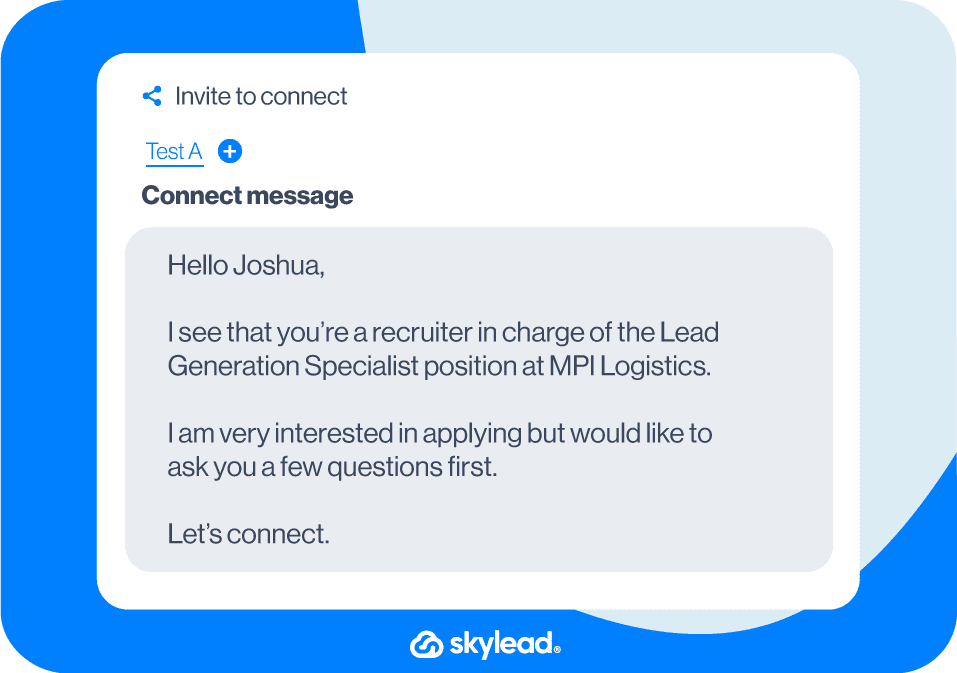
Intro to a collaboration proposal
Template
Hello {{firstName}},
I am a long admirer of your work.
I followed your advice regarding {{topic}} that you shared {{where}}. {{achievedResult}}.
Thank you once again!
Would love to connect!
Example
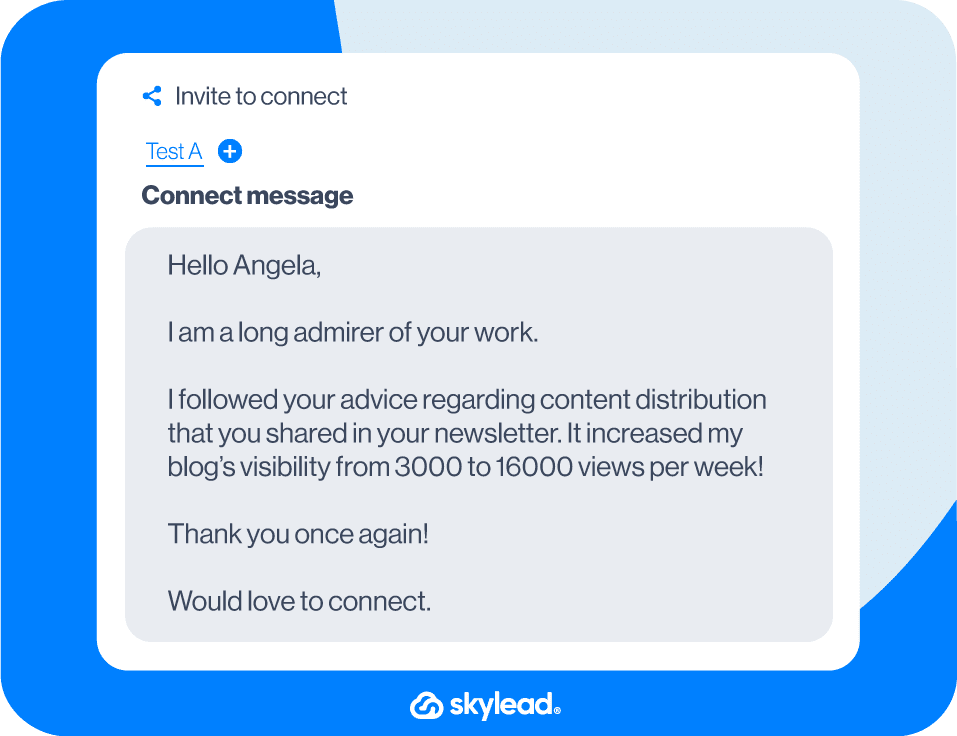
Connect with a member of the community
Template
Hello {{firstName}},
Your post in {{mutualCommunity}} was quite insightful.
I particularly liked the part where you said {{quote}}.
I would like to discuss it further with you. Let’s connect.
Example
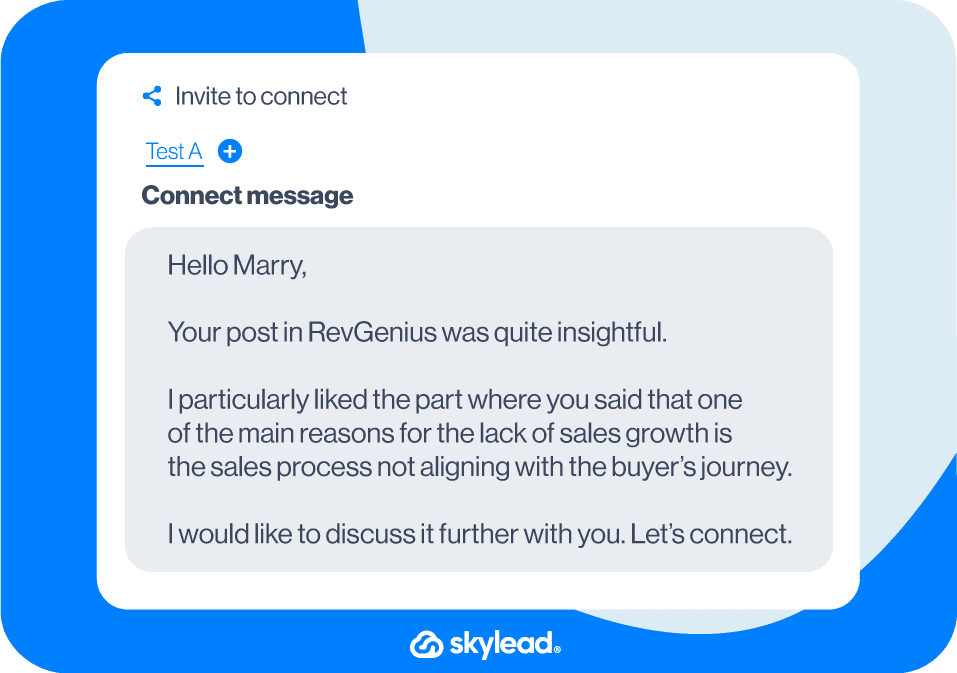
OR
Template
Hello {{firstName}},
I saw that you are also a member of {{mutualGroup}}.
I would love to connect with you since we both work in the {{industry}} industry.
Example
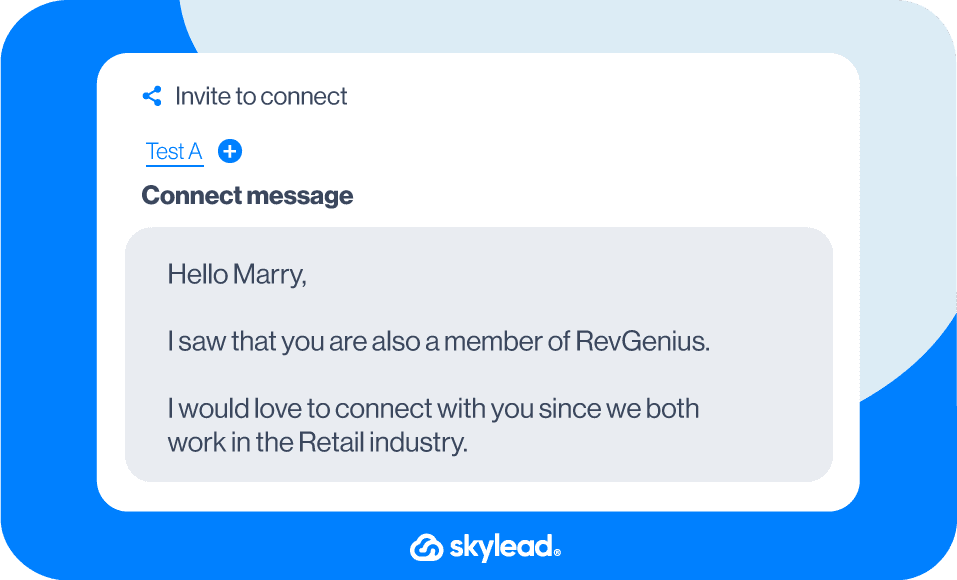
Approach an event attendee
Template
Hello {{firstName}},
It was great speaking to you at the {{eventName}} {{when}}.
What you do at {{currentCompany}} sounded fascinating and it totally inspired me!
I’d definitely like to stay up-to-date with your work.
Thank you in advance for connecting!
Example
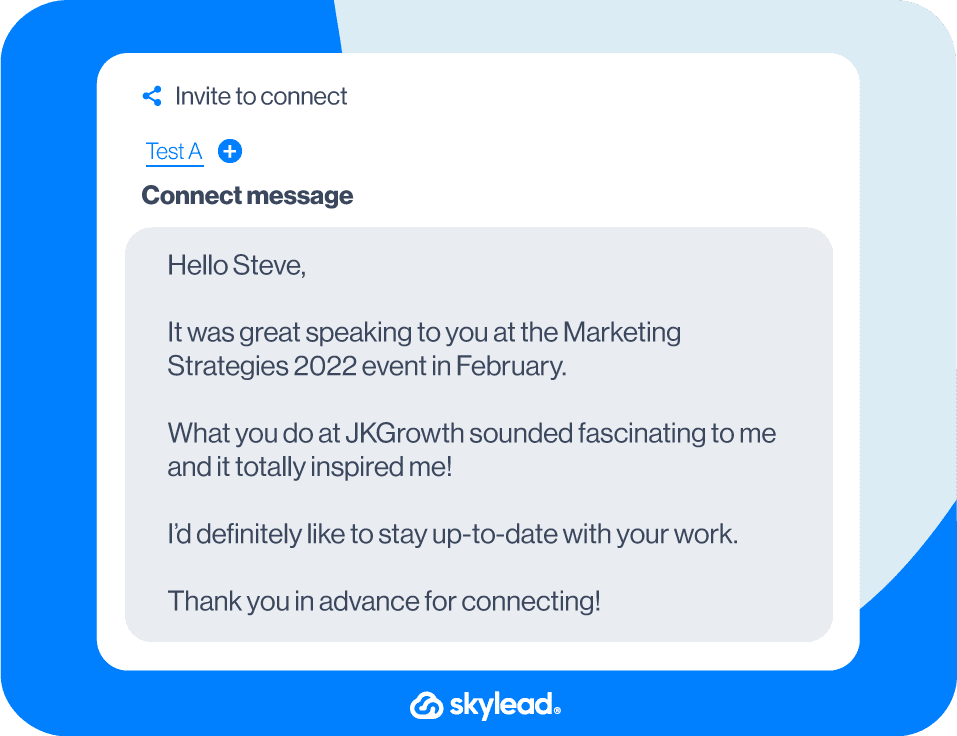
OR
Template
Hey {{firstName}},
I saw you at the {{eventName}} but I didn’t get the chance to approach you and introduce myself. How did you like the {{eventName}}? Would love to connect here and stay in touch!
Example
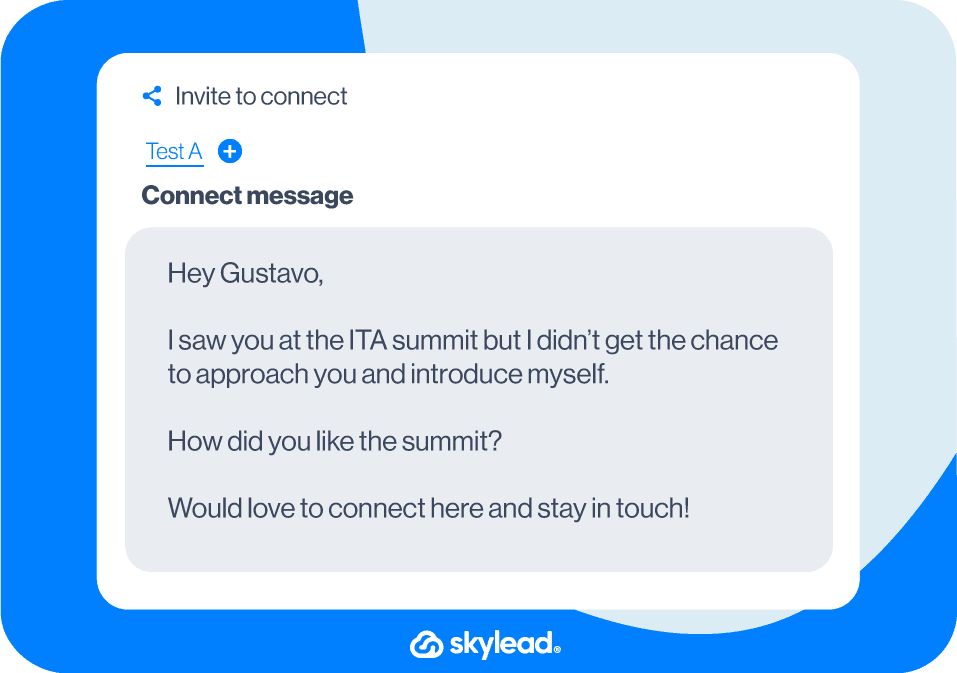
Reach out to a LinkedIn event attendee
Template
Hello {{firstName}},
I saw that you too attended the {{eventName}} LinkedIn event.
Learning {{what}} was particularly useful for my business.
Anyways, I would love to connect and exchange feedback on the event.
Example
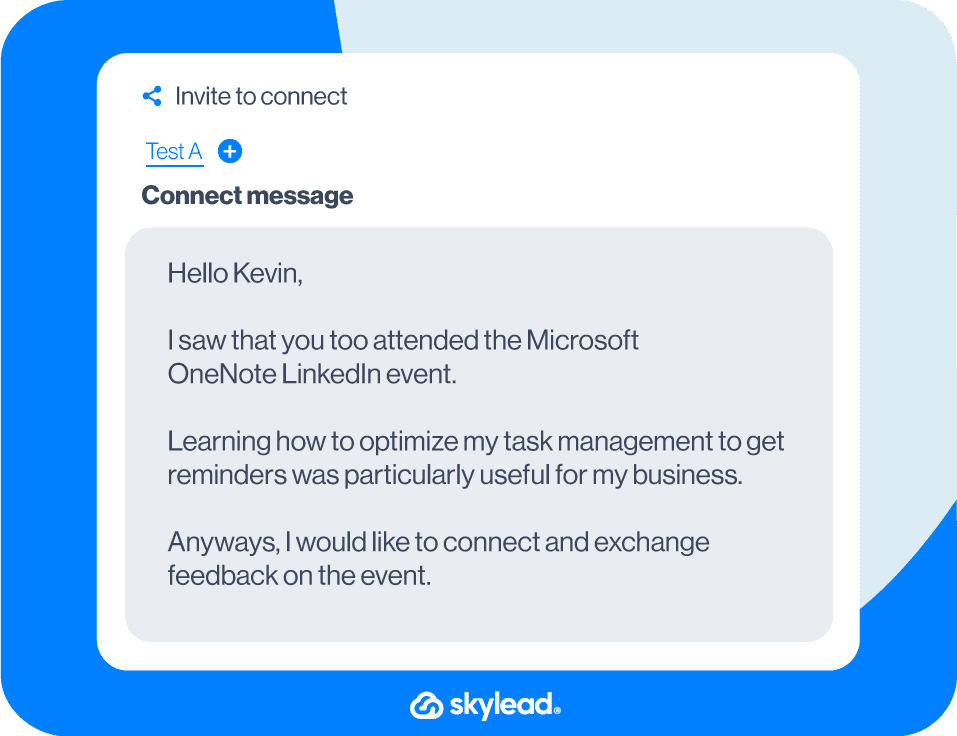
Reach out to an author of a LinkedIn article or post
Template
Hi {{firstName}},
I came across your LinkedIn article on {{topic}}.
I really resonated with your thoughts on {{topic}}.
I’d love to keep in touch and learn more about your work.
Example
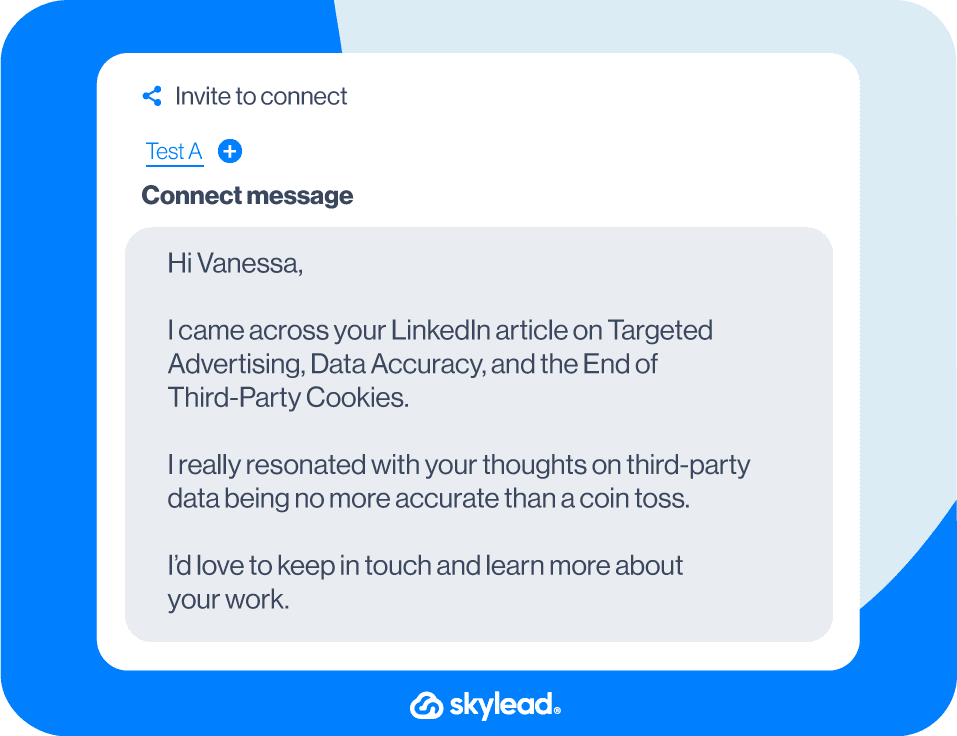
Break the ice using industry humor or a joke
Here are 35+ industry jokes that you could use in your LinkedIn connection requests as an icebreaker.
Template
Hi {{firstName}},
How many therapists does it take to change a light bulb?
Just one - but the light bulb has to really want to change.
Jokes aside, I would love to connect!
Example
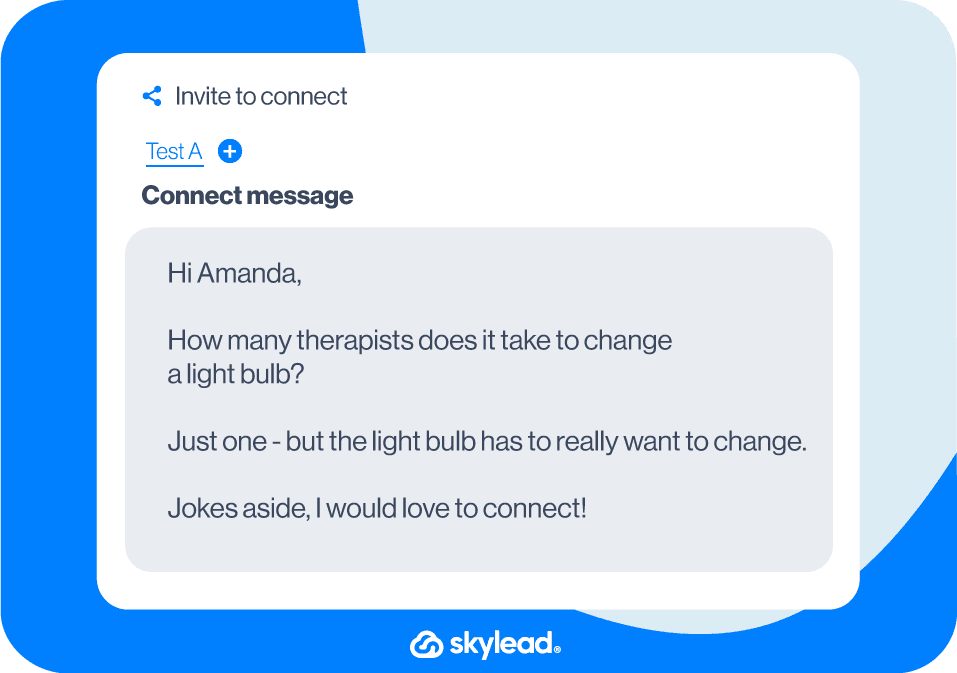
OR (something as silly as this)
Template
Hello {{firstName}},
I noticed we both breathe oxygen.
Sounds like a perfect fit to me, let’s connect!
Example
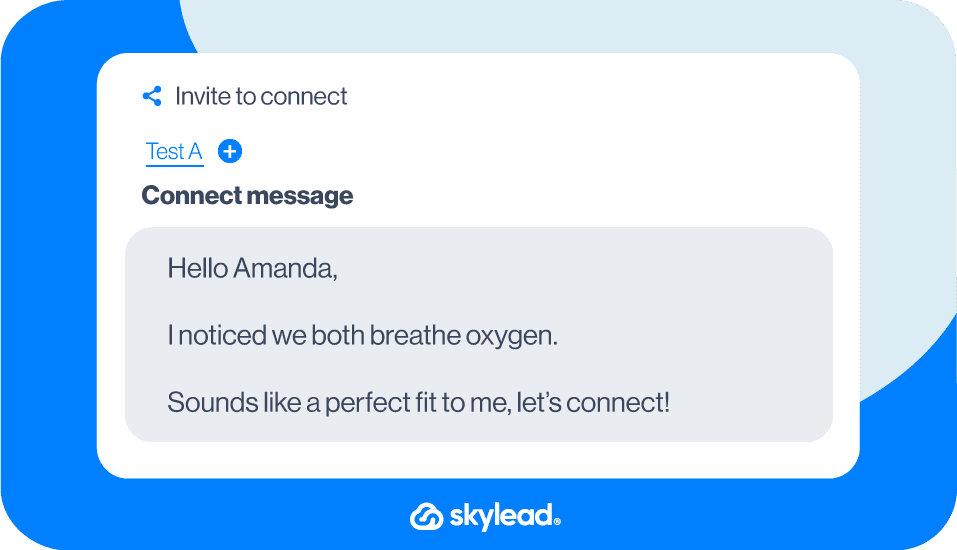
Connect with a former colleague
Template
Hello {{firstName}},
Remember me?
We used to work together at {{company}} back in {{year}}.
Let’s connect and catch up, I would love to hear how it is going at {{currentCompany}}!
Example
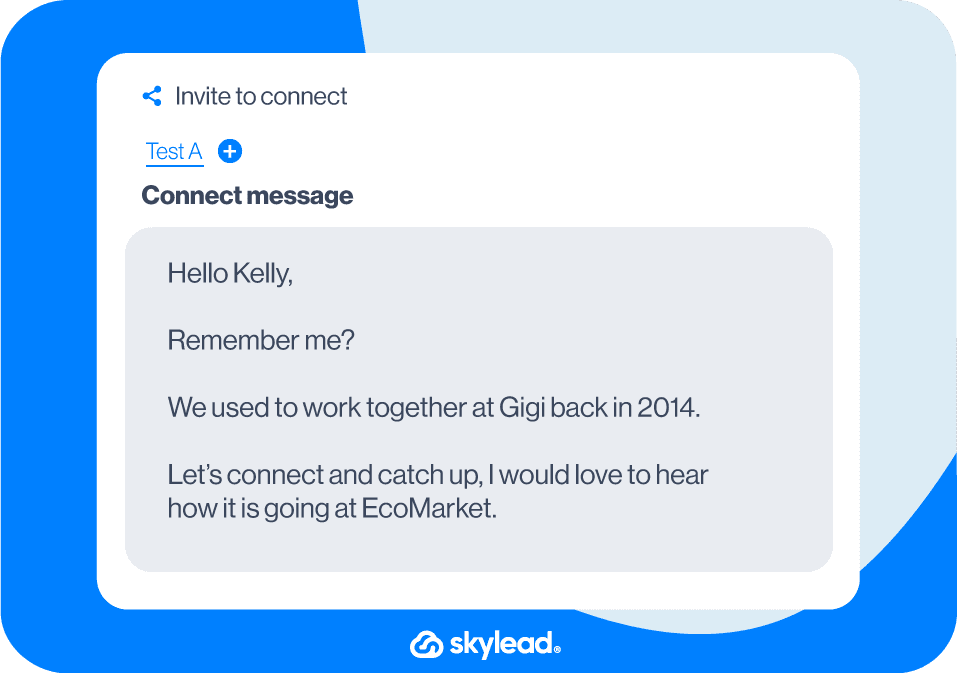
OR
Template
Hello {{firstName}},
It was such a pleasure working with you at {{company}} back in {{year}}.
Let’s connect! I would like to hear what you’ve been up to professionally since.
Example
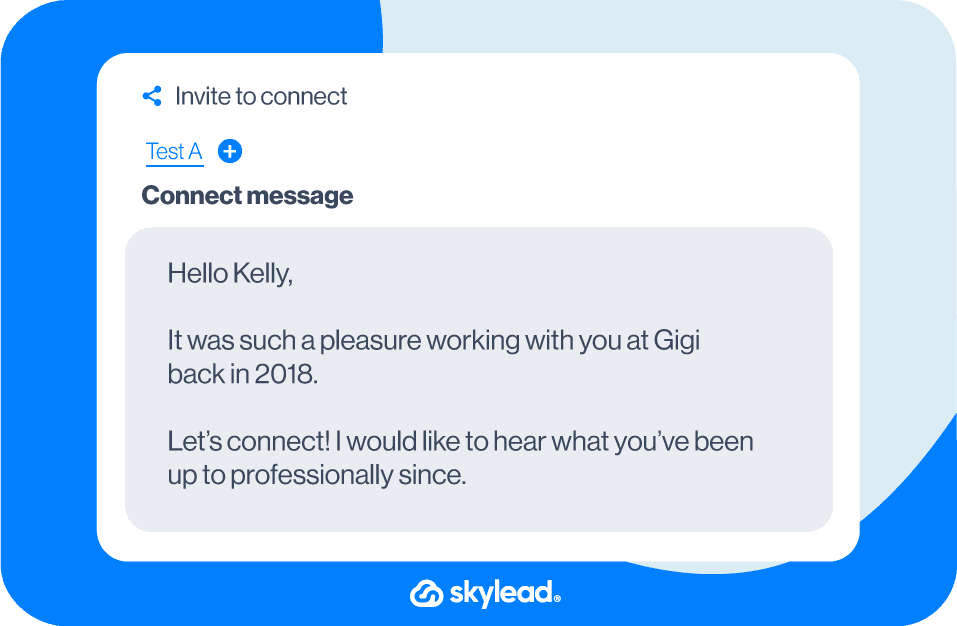
Reach out to a colleague
If a company is big, knowing everyone you’re working with is hard.
However, connecting with colleagues is a good practice for expanding your network on LinkedIn.
Remember that they also might have some interesting connections, and you never know who they could introduce you to.
Template
Hello {{firstName}},
Good news travels fast! I heard about you {{achievement}}. Great job!
Anyways, I am {{yourName}} from the {{department}} team and would love to connect!
Example
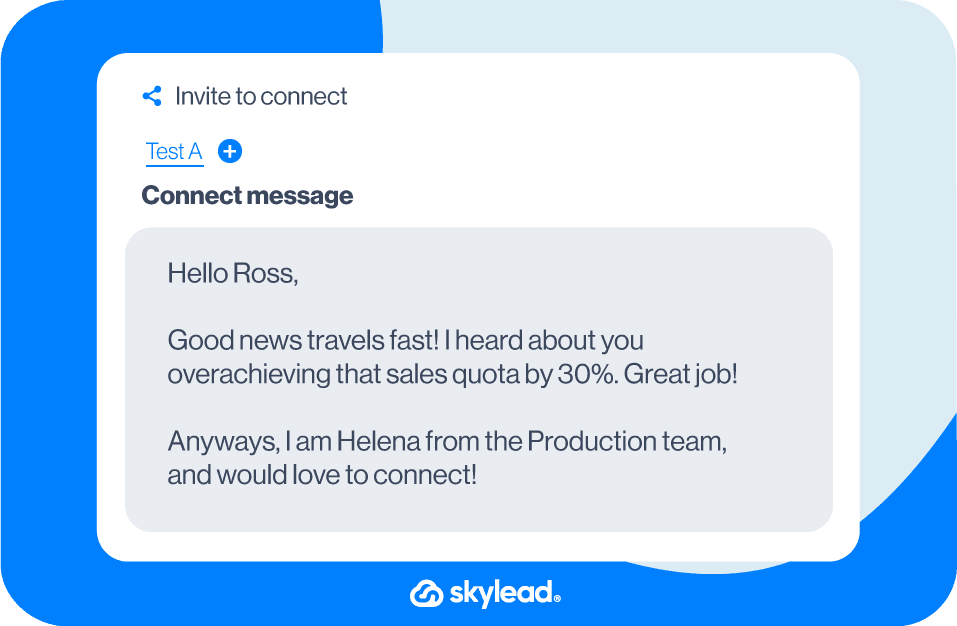
Connect with former alumni
Template
Hello {{firstName}},
I see that we graduated from the same university. Go {{school’sSportsTeam}}! 🙂
I would like to connect and learn more about your experience at {{company}}.
I myself majored in {{major}} and currently work in the {{industry}} industry.
Example
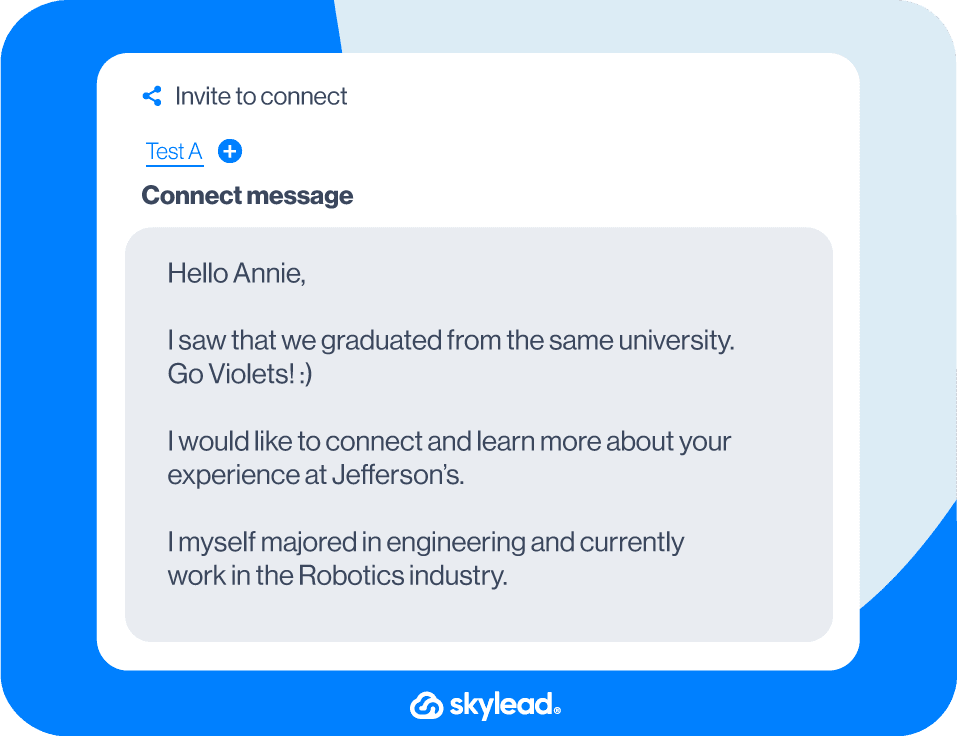
Reach out to members who reacted to your or someone else’s LinkedIn post
Template
Hello {{firstName}},
I saw that you are also a fan of {{name}}’s content and just wanted to connect with you.
Example
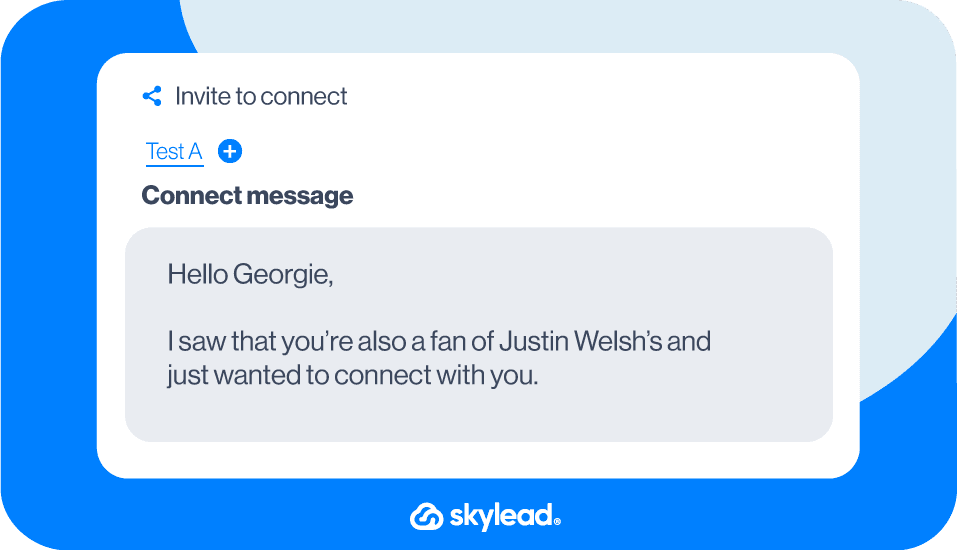
OR
Template
Hello {{firstName}},
I saw that you also liked {{Name}}’s post on {{topic}}. I am a big fan of his/her work.
His/her advice worked well for me!
Anyways, I would love to connect and maybe even discuss it further.
Example
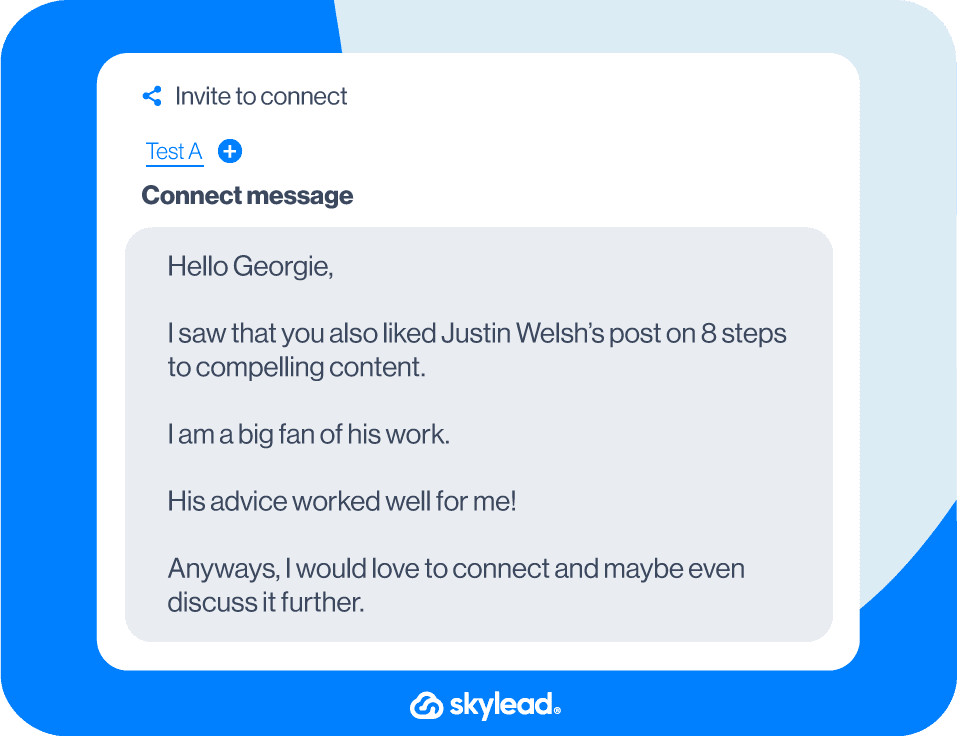
Connect with a member who asked a question in the post comment
Template
Hi {{firstName}},
I saw that you commented on {{name}}’s post about {{topic}} and asked {{question}}.
I would like to connect and share some resources with you that could be helpful.
Example
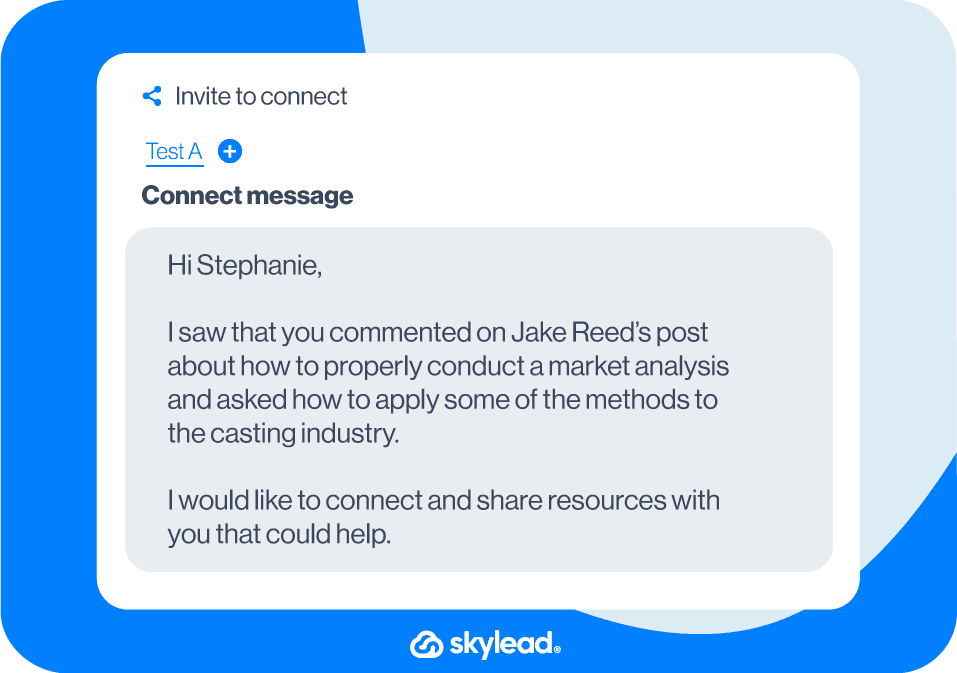
Reach out to members suggested by LinkedIn
The People also viewed feature displays a list of LinkedIn members that the platform’s algorithm found important for your LinkedIn experience, whether you are using it for networking, job search, or lead generation.
Use this template to reach out to them.
Template
Hello {{firstName}},
Your profile came as suggested through the People also viewed section, so I was curious and checked it out. I saw that we’re both in the {{industry}} industry, so I thought we connect and exchange experiences.
Example
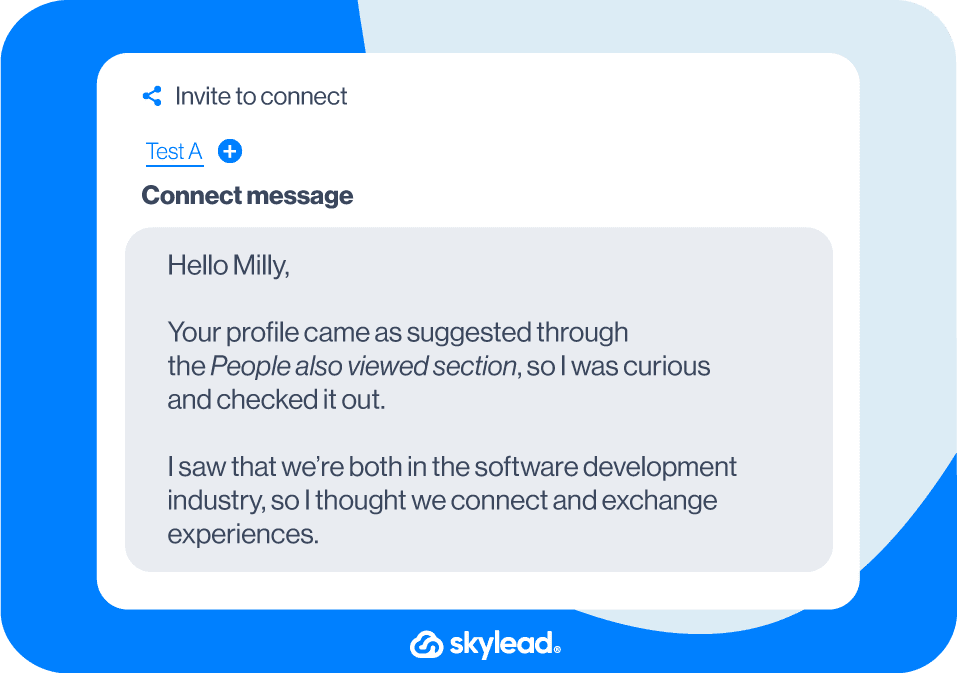
OR
Template
Hello, {{firstName}}
LinkedIn suggested your profile several times now, so I was curious and checked it out. I saw that we’re both {{occupation}}, so I thought it would be good to connect with professionals from the industry. Let’s exchange experiences:)
Example
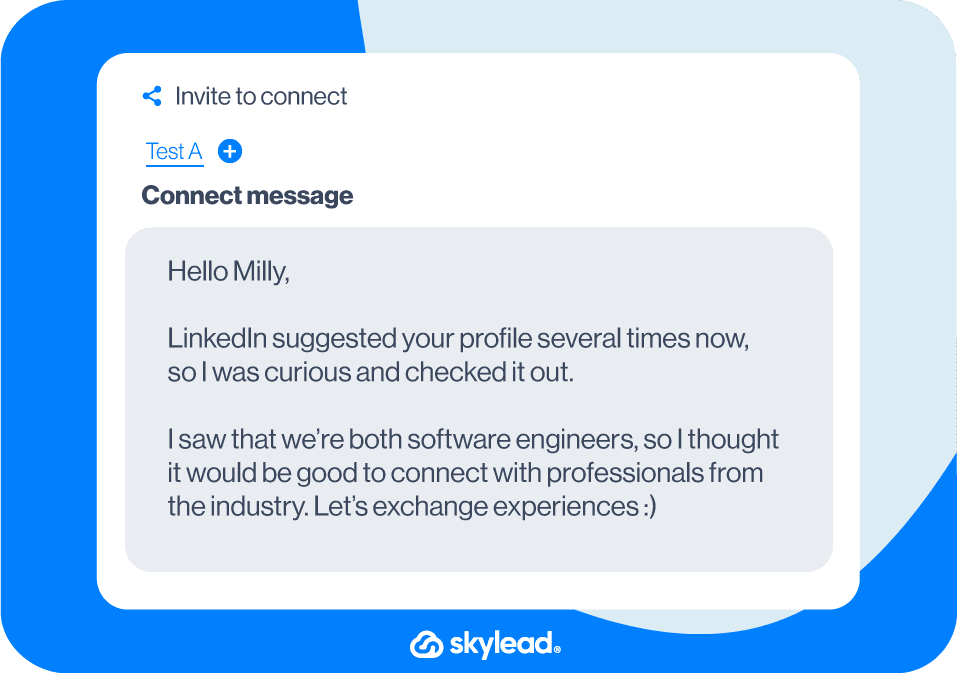
Start with a genuine compliment
Template
Hi {{firstName}}
I have been following your work for some time now, and I must admit your career path in the {{industry}} industry impressed me. I would love to connect with you and ask you a few questions about your beginnings in the field.
Example
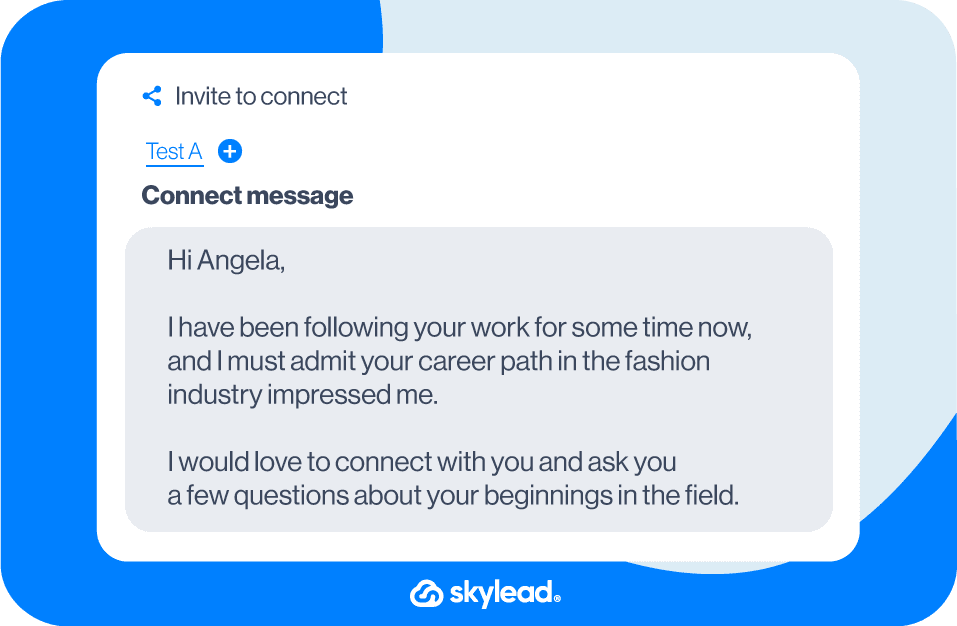
LinkedIn Connection Message: FAQ
How can one effectively track and measure the success rate of these LinkedIn connection message templates, especially in terms of resulting in meaningful professional relationships or business opportunities?
To effectively track the success of LinkedIn connection message templates, monitor acceptance rates and follow-up interactions. Analyzing these metrics can provide insights into which templates foster meaningful connections and opportunities. Adjust strategies based on this data for improved outcomes.
What are the best practices for following up on a connection request if there's no response initially, without coming across as too persistent or spammy?
Following up on a LinkedIn connection request requires a delicate balance. If there's no initial response, a polite and concise reminder after a reasonable period can be appropriate. Avoid being overly persistent; one InMail or email follow-up is generally considered tactful to maintain professionalism without seeming spammy.
How do you politely ask for a connection on LinkedIn?
Asking to connect with someone on LinkedIn has become as common as asking or giving your business card to someone. Many professionals include links to their profiles in the paper or QR business cards or in the signature section of their emails.
Should I send a message with a connection request on LinkedIn?
Adding a message with a connection request on LinkedIn is generally considered good practice that increases your acceptance rate. However, sending a blank request rather than a generic message is better if you decide not to use a personalized approach. Check out our examples above.
What message to write with a connection request on LinkedIn?
Mentioning something that you have in common with the person you are trying to connect with is generally considered good practice that increases your chances of getting accepted. However, there are many other LinkedIn connection request messages that you can use. Check out our examples to get inspired.
How do I send a cold connection request on LinkedIn?
The cold connection request is not “as cold” as it seems if you follow the golden rule of connecting to people relevant to your business or with whom you have something in common. Therefore, the best way to connect on LinkedIn is by mentioning something relevant to both of you.
Did someone reject my connection request on LinkedIn?
You can ignore someone’s connection request on LinkedIn by clicking “Ignore” instead of “Accept” or by ignoring it and letting it pend. LinkedIn does not notify the sender when their connection request has been declined. Also, LinkedIn automatically deletes pending connection requests after 6 months.
What happens when you ignore a connection request on LinkedIn?
To decline someone’s connection request, just click “Ignore”. LinkedIn will not notify the member of their request being declined, but they can send you another connection request. If you literally ignore the request and leave it pending, LinkedIn will automatically delete it after 6 months.
Do LinkedIn requests expire?
Yes, LinkedIn requests expire. All pending LinkedIn connection requests will be automatically deleted after 6 months. After that, the member whose request has been deleted can ask for another connection again.
Can people see withdrawn LinkedIn requests?
Your recipient won’t be notified if you withdraw your connection request on LinkedIn. To do that, go to My Network > Manage (top right corner) > Sent > Withdraw. If the LinkedIn member already accepted your invitation to connect, they can be removed as a connection.
How do you know if someone accepted your LinkedIn request?
You will get a notification when someone accepts your connection request. To set up notifications, go to Settings & Privacy > Notifications > Connecting with others > Invitations to connect. Or, go to My Network > Connections (top left corner) > Recently added > See the list of recently added connections or search them by name.
How many content writers does it take to change a lightbulb?
Doesn’t matter, the head of marketing will change it anyway.
Jokes aside, the answer is - none. Because content writers don’t like to change anything.
Plus, the light bulbs don’t really change, they’re replaced.
I’ll stop now.
Ok, maybe your first thought was not to add me to your LinkedIn network after reading my cringe jokes, but you would be surprised how well people react to humor in outreach. So, if you ever wondered what the best way to expand your network is or how to outreach the leads you found via prospecting on LinkedIn, then industry-related jokes in your Connection Request Messages, LinkedIn InMails, or LinkedIn Messages are definitely top of the list.
A good industry-related joke not only helps your acceptance and response rates, but also creates a positive first impression between the two. I personally tend to use them in my Connection Request Messages, but they can be a great conversation starter in messages for LinkedIn lead generation as well.
Since I know how hard it is to find industry-related jokes, I decided to do a little research for you and put them all in one place. This way I want to make using humor to expand your network on LinkedIn a little bit less time-consuming and to encourage you to get bold and creative in your outreach.
Expand your network: How to use humor in outreach?
As mentioned before, a good joke finds its place anywhere you want. Use it to connect with other LinkedIn members, to start a conversation, or to make a hook for a potential business proposal in an InMail.
There are multiple ways to use an industry-related joke in your outreach.
Example #1
Use the joke as the opener when networking on LinkedIn.
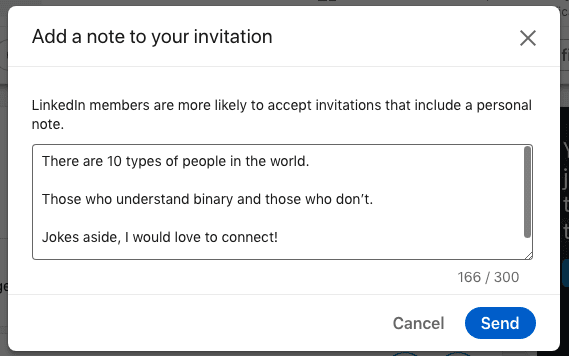
Example #2
Use the joke as the opener, but add a personal note to it.
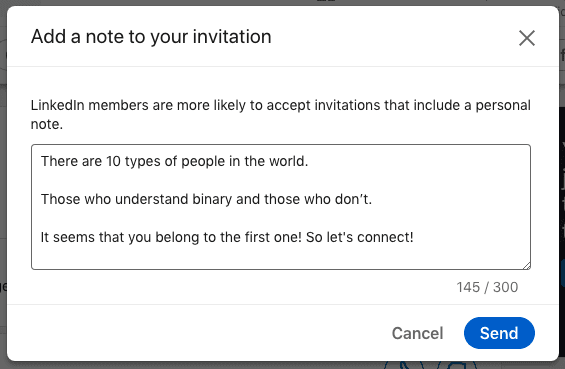
Example #3
Make the joke part of your hyper-personalized message to expand your network on LinkedIn.
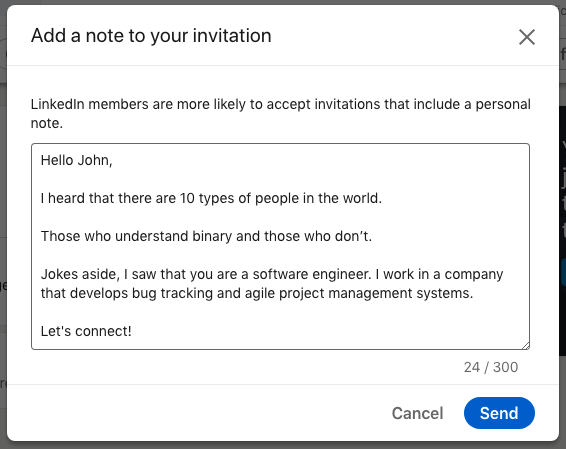
Here is the list of jokes for:
- Sales representatives;
- Marketers;
- Managers;
- Developers;
- Customer Support Specialists;
that you can use right away or combine them in your outreach.
Dos and Don’ts when using humor to expand your network
DOS
- Do the research before you choose the joke that you want to use. Consider each person’s unique cultural background and personal story. You want it to be relevant to the person you are talking to.
- Make sure that the joke is not offensive or maybe on the edge of being offensive.
- Have in mind that you are reaching people whose sense of humor you don’t know. A joke that is funny to you might not be to them. So don’t take things too personally in case they don’t take the direction that you wanted. However, people usually react well to humor.
- Do get to the punchline fast. Be short.
- Do laugh at yourself when you get a chance. Telling a joke that you made up from your personal experience always works. It makes you more human and approachable, and people generally love to work with people who don’t have a problem laughing at themselves.
DON’TS
- Don’t force a joke where it doesn’t belong.
- Don’t use jokes that talk bad about someone or call someone out, even if it’s their/your competition. It is not only rude and pathetic but unprofessional and it doesn’t make you look good at all.
- Avoid jokes that have to do with current hot-topics, that are political, or have to do with anyone’s sexual or religious orientation. No one wants to hear that or have those kind of people in their professional (or personal, for that matter) network.
- Don’t overdo it. Know when to stop. If someone answers back with a joke or a funny punchline, make sure that you know when joking about the same topic becomes too much.
Jokes for salespeople
Expand your network on LinkedIn by incorporating these sales jokes in your LinkedIn Connection Request Messages, Messages, or InMails.
Sales Joke #1
Always trust a glue salesman.
They tend to stick to their word.
Sales Joke #2
How do salespeople traditionally greet each other?
Hi. Nice to meet you. I’m better than you.
Sales Joke #3
What did the horrible buyer say to the salesperson who had a 24h deadline?
Give me another week to think about it.
Sales Joke #4
What salesman has the slickest line?
A hair grease salesman.
Sales Joke #5
How many salespeople does it take to change a light bulb?
None. You don't need a new light bulb - you need to upgrade your socket to the newest version.
Jokes for marketers
Expand your network on LinkedIn by incorporating these marketing jokes in your LinkedIn Connection Request Messages, Messages or LinkedIn InMails.
Marketing Joke #1
How did Yoda get his first lead?
He used the SalesForce.
Marketing Joke #2
What is the safest place to hide a body?
The second page of Google.
Marketing Joke #3
Why did the marketing couple break up?
They weren’t on the same landing page.
OR
Lack of engagement
Marketing Joke #4
How many marketers does it take to screw in a light bulb?
None – they’ve automated it.
Marketing Joke #5
Why don’t marketer’s like trampolines?
They’re scared of high bounce rates.
Marketing Joke #6
How do SEO experts celebrate improved search rankings?
SERP-rise parties.
Marketing Joke #7
Why do digital marketers love to shop at Whole Foods?
They have a lot of organic content.
Marketing Joke #8
What’s a marketer’s favorite drink?
Brand-y.
Marketing Joke #9
What’s a pirate’s favorite type of content?
A webinAAARRRR!
Marketing Joke #10
What does the SEO professional see when they see twins?
Duplicated content.
Marketing Joke #11
Why do SEO experts love driving during peak hours?
They appreciate the traffic.
Marketing Joke #12
An SEO copywriter walks into a bar, bars, tavern, pub, pubs, public house, Irish, bartender, drinks, beer, wine, liquor.
Jokes for managers
Expand your network on LinkedIn by incorporating these management jokes in your LinkedIn Connection Request Messages, Messages, or InMails.
Management Joke #1
What is the hardest part of being a product manager?
Explaining what you do to your parents and friends.
Management Joke #2
How many managers does it take to change a light bulb?
A roomful - they have to hold a meeting to discuss all the ramifications of the change.
Management Joke #3
Don’t stand around doing nothing.
People will think you’re the manager.
Management Joke #4
How many project managers does it take to change a lightbulb?
None, they are all still discussing the best way to do it.
Management Joke #5
A product manager walks into a bar.
It isn't what he expected so he immediately blames development for no reason.
Jokes for developers
Expand your network on LinkedIn by incorporating these software engineer jokes in youConnection Request Messages, Messages, or InMails.
Developer Joke #1
Why did the front-end developer buy the flat under his?
He always wanted a sub-domain.
Developer Joke #2
A developer’s wife asks him - Would you go to the store and pick up a loaf of bread? And if they have eggs, get a dozen.
The developer returns home with 12 loaves of bread. They had eggs, he explained.
Developer Joke #3
Why do programmers always mix up Christmas and Halloween?
Because Dec 25 is Oct 31.
Developer Joke #4
If doctors were like software engineers, they would say things like “Have you tried killing yourself and being reborn?”
Developer Joke #5
A developer is a tool that transforms caffeine into code.
Developer Joke #6
Give a man a program, frustrate him for a day.
Teach a man to program, frustrate him for a lifetime.
Developer Joke #7
Software undergoes beta testing shortly before it’s released.
Beta is Latin for 'still doesn’t work’.
Developer Joke #8
What do you call a software wizard that installs applications?
The Wizard of OS.
Developer Joke #9
What's the difference between a junior software engineer and a senior software engineer?
A senior software engineer writes wrong code faster.
Jokes for customer support specialists
Expand your network on LinkedIn by incorporating these CSS jokes in your LinkedIn Connection Request Messages, Messages or InMails.
CSS Joke #1
Evil queens are just Disney princesses who worked in Customer Support too long.
CSS Joke #2
Those who say “there is no such thing as a stupid question” obviously never worked in Customer Care.
CSS Joke #3
Anyone who ever said that “the customer is always right” has never worked in Tech Customer Support.
CSS Joke #4
Customer Service is like…
If you understand English, press 1.
If you do not understand English, press 2.
Frequently asked questions
How effective are humorous templates across various industries, especially in more conservative fields?
Humorous templates' effectiveness varies across industries. In conservative fields, they may be less appropriate. Tailoring the humor to suit the industry's tone can improve reception.
What are the best practices for personalizing jokes to ensure they resonate well with specific audiences or sectors?
Personalizing humor involves understanding the recipient's background, industry norms, and possibly their company culture to ensure the joke aligns with their professional environment.
Are there examples of negative reactions or feedback to consider when using humor in professional outreach?
Negative reactions to humor in professional outreach are possible, especially if the humor is misinterpreted or deemed unprofessional. It's crucial to balance humor with professionalism and consider the potential for diverse interpretations.
Summary
Jokes that you use in your outreach or in real life quickly impact your personal brand image and reputation, for good or bad. Ideally, whoever you talk to shares your sense of humor and can understand a light-hearted critique of the industry.
As mentioned above, here we’ve listed jokes that you can use right away for:
- Sales representatives;
- Marketers;
- Managers;
- Developers;
- Customer Support Specialists.
Be bold in your outreach. It will for sure pay off.
And for the end:
How many marketers does it take to generate 10 times more leads in less time?
None, they use Skylead.
If you send a connection request to someone but fail to follow up with something as simple as Thank you for connecting on LinkedIn, you will almost certainly be forgotten about in a matter of hours. Maybe even seconds.
It doesn’t mean that your professional experience and what you do matter less. It’s just, that we are being bombarded with so much content, social media interaction, and trivial, everyday things, all of which easily draw our attention away from anything that doesn’t capture instant interest.
That’s why sending an original and well-timed Thank you for connecting on LinkedIn and using its benefits later. In many cases, this practice turned out to improve your visibility, and therefore crucial for further communication and even collaboration.
We’ve put together this blog with keeping in mind all of this. Hence, here are:
- The elements of a good LinkedIn Thank you for connecting message,
- How to spend less time on LinkedIn but build more meaningful relationships,
- 12 templates on how to thank someone for connecting on LinkedIn without just sending Thanks for connecting and stay remembered in the long run.
What makes a good Thank you for connecting message on LinkedIn? [4 Best practices]
Keep it short
And sweet. No need to write War and Peace. It’s enough to thank them for accepting your invite and to expand on what you wrote in your LinkedIn connection request message (‘cause you didn’t just send a blank note, did you?).
We’ll elaborate on what to write after that simple Thank you for connecting contained in pretty much every message and how to personalize it to strengthen your business relationship.
Don’t try to sell
Ohhhh, this is a big no-no. The only thing worse than trying to sell when thanking someone for connecting in a LinkedIn message is doing so in a connection request. Use this occasion to start a conversation that later can lead to sales instead. Check out the ‘Templates section’ below to get inspired.
Make it about the lead
Don’t introduce yourself in a conventional way - ‘Hi, my name is…’ and then talk exclusively about your business and professional successes. Don’t force your product or your services. Instead, shift your attention to asking meaningful questions about your lead, and get off to the right start. You’ll have plenty of time to sell. And successfully.
Focus on the value
Following up on the previously said, show your lead that they can benefit from you in some way. If that transition doesn’t come smoothly, you can speak about how you can mutually benefit from each other. Show them what problems and challenges you can potentially solve and they will, if nothing else, for sure appreciate the effort.
Thank you for connecting on LinkedIn: 12 Templates
Sure, today we have Chat GPT, and you might think that it could give you all the answers on how to thank someone for connecting on LinkedIn.
We are not against AI, we actually encourage everyone to use ChatGPT for sales (we’ve put prompt examples too!). So, copy & paste our templates, or use them as prompts to make Chat GPT inspired in the right direction.
However, we will share some of the best-performing LinkedIn Thank you for connecting messages that our Head of Sales, Andrea, uses in her everyday communication for more effective LinkedIn lead generation.
Hopefully, these will get you inspired to include this kind of practice in your LinkedIn lead generation routine.
After connecting with members you don’t know personally
Option #1 to send a Thank you message on LinkedIn
Example
Hey Sonia,
Thank you for accepting my invitation.
I don’t believe we met in person.
As someone open to networking and building new business relationships, I just wanted to greet you, check in with you regarding the challenges you are facing, and see how we both might benefit from this connection.
Have a great day!
Template
Hey {{firstName}},
Thank you for accepting my invitation.
I don’t believe we met in person.
As someone open to networking and building new business relationships, I just wanted to greet you, check in with you regarding the challenges you are facing, and see how we both might benefit from this connection.
Have a great day!
Option #2 to send a Thank you message on LinkedIn
If you want to make an extra effort, which usually pays off, create a personalized Image or GIF to thank someone for connecting on LinkedIn. It could improve your response rate by over 20% (word! We’ve tested it out!)
Skylead’s native Image & GIF personalization is available to all our users, at no additional cost, and without ever leaving the software dashboard.
The example below was used as a Thank you message which was part of the sequence Target specific group members.
The sequence scored 53% in acceptance rate, 27% in reply rate, and 73% in open rate.
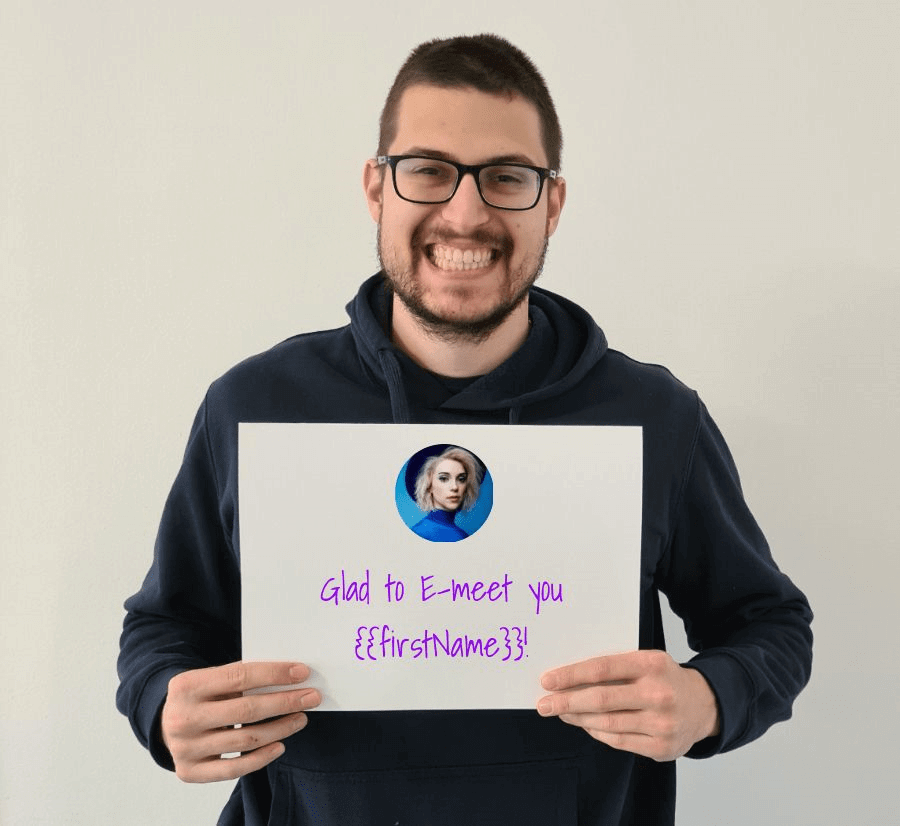
After connecting with members you met an event
Example
Hey Johnny,
Thank you for accepting my invitation.
Once again, it was a pleasure chatting with you at ‘Entrepreneurs Roundtable: The 411 on SEO and Google Analytics - What’s working now?’.
I would really like to continue the conversation we had at the event regarding the SEO tactics your company used to improve its blog ranking from the 3rd page of Google to the top 3 rated in the sales industry. So much to say so little time!
Let’s chat here or schedule a call, let’s say next Thursday around 2 pm.
How does that sound?
Template
Hey {{firstName}},
Thank you for accepting my invitation.
Once again, it was a pleasure chatting with you at {{eventName}}.
I would really like to continue the conversation we had at the event regarding {{topic}}. So much to say so little time!
Let’s chat here or schedule a call, let’s say {{day&time}}.
How does that sound?
After connecting with someone you have a mutual connection with
Example
Hello Jamie,
In the spirit of networking, I would like to hear more about you and also introduce myself.
You are the Head of Sales at FlyProject, aren't you?
I know several people from there, do you know Matthew Stone?
Btw, thanks for connecting with me!
Template
Hello Jamie,
In the spirit of networking, I would like to hear more about you and also introduce myself.
You are {{occupation}} at {{company}}, aren't you? I know several people from there, do you know {{mutualConnection’sFullName}}?
Btw, thanks for connecting with me!
If you wish to offer help to your new connections
Example
Hello Josh,
Thanks for accepting my invitation.
I am delighted to connect with you.
I would like you to let me know if there’s anything I can do to assist you with. It would be my pleasure!
Have a fabulous day!
Template
Hello {{firstName}},
Thanks for accepting my invitation. I am delighted to connect with you.
I would like you to let me know if there’s anything I can do to assist you with. It would be my pleasure!
Have a fabulous day!
Providing value for your connections as a way to thank someone for connecting on LinkedIn
Example
Hello Mark,
It’s great to be part of your network!
As I mentioned earlier, I recently wrote a blog that might help you with the problem you expressed in the ‘Startup Specialists’ Group.
I actually had the same issue with developing internal processes since we were growing pretty fast as a startup. This experience inspired me to write a series of blogs on the topic. Maybe it will help you figure out where to start.
Let me know if there is anything else I can help you with.
Template
Hello {{firstName}},
It’s great to be part of your network!
As I mentioned earlier, I recently wrote a blog that might help you with the problem you expressed in {{groupName}}. I actually had the same issue with {{issue}}. This experience inspired me to write a series of blogs on the topic. Maybe it will help you figure out where to start.
Let me know if there is anything else I can help you with.
Introduce them to someone from your network to thank them for connecting on LinkedIn
Example
Hey Steve,
Thanks for connecting on LinkedIn. I would like to know more about you and your business. If there’s anything I can help you with or introduce you to someone in my network, please let me know.
Kind Regards,
Jim
Template
Hey {{firstName}},
Thanks for connecting on LinkedIn. I would like to know more about you and your business. If there’s anything I can help you with or introduce you to someone in my network, please let me know.
Kind Regards,
{{yourName}}
Show genuine interest in your lead’s work
Example
Hi Selena,
Thank you for accepting my invitation. I am looking forward to learning more about your business expertise.
Please have a look at my connections and if there is someone you would like to be introduced to I am happy to make the connection. I am here to make meaningful connections because I deeply believe in networking!
Thanks again for your acceptance, and if you have any questions for me, please don’t hesitate to reach out.
Best regards!
Template
Hi {{firstName}},
Thank you for accepting my invitation. I am looking forward to learning more about your business expertise.
Please have a look at my connections and if there is someone you would like to be introduced to I am happy to make the connection.
I am here to make meaningful connections because I deeply believe in networking! Thanks again for your acceptance, and if you have any questions for me, please don’t hesitate to reach out.
Best regards!
After connecting with someone whose content you read
Example
Hey Michelle,
I am so glad to be part of your network! Thank you for accepting my invitation.
As mentioned in my previous message, your last post on the importance of employee branding really resonated with me, especially the part where you say that ‘employee branding is not only about the people who already work at your company, but also about the professionals that apply for jobs and their recruiting experience”. It really made me revise the entire recruitment process.
Again, thanks for accepting my invite to connect, and I really hope we’ll have the chance to chat in the future.
Have a great day!
Template
Hey {{firstName}},
I am so glad to be part of your network! Thank you for accepting my invitation.
As mentioned in my previous message, your last post on {{postTopic}} really resonated with me, especially the part {{quoteParagraphThatResonated}}. It really made me revise {{whichPartOfYourBusiness}}.
Again, thanks for accepting my invite to connect, and I really hope we’ll have the chance to chat in the future.
Have a great day!
Use email to thank them for connecting on LinkedIn
In some cases, email conversation is more in line with your business outreach strategy or it’s your lead’s preferred channel of communication. For the sake of higher engagement and response rates, you can thank them for connecting on LinkedIn via email. Additionally, email outreach can be beneficial for starting sales-oriented conversations.
Example
Hello Mark,
I just wanted to thank you for accepting my LinkedIn Connection Request here as well in case you prefer email communication.
Anyways, I love the question you recently posted in the Digital Marketers group regarding the optimal content posting schedule to draw traffic to your website. I actually wrote an article covering that topic in particular, I’ll just leave you a link here.
However, if you need a more personalized and thorough insight, we can schedule a call and meet up, let’s say next Wednesday at 3pm. How does that sound?
Thank you once again for accepting my Connection Request on LinkedIn.
Best,
Matt
Template
Hello {{firstName}},
I just wanted to thank you for accepting my LinkedIn Connection Request here as well in case you prefer email communication.
{{yourSalesPitch}}
Thank you once again for accepting my Connection Request on LinkedIn.
Best,
{{yourName}}
‘Break the ice’ by congratulating them on their success in the LinkedIn Thank you for connecting message
Example
Hey Sharlane,
Thanks for accepting my Connection Request!
Once again, congratulations on your promotion to the Head of Growth at Jumbos. I am always excited to see professionals with such enviable backgrounds progress and hold decision-making positions.
Let’s keep in touch.
Template
Hey {{firstName}},
Thanks for accepting my Connection Request!
Once again, congratulations on your promotion to {{occupation}} at {{company}}. I am always excited to see professionals with such enviable backgrounds progress and hold decision-making positions.
Let’s keep in touch.
Show genuine interest in a shared experience
Example
Hey Marissa,
Thanks for connecting!
Btw, I noticed you also worked at Johnsons & Parker. I spent a couple of years there too, it was probably one of the best work experiences I’ve had.
What about you, did you like it?
Anyway, glad to be in your network!
Template
Hey {{firstName}},
Thanks for connecting!
{{ReferenceToASharedExperience}}
Anyway, glad to be in your network!
Hyper-personalize your Thank you for connecting messages at scale [and more]
Skylead is a LinkedIn automation tool and cold email software that allows you to combine LinkedIn automation, unlimited Email automation, Email verification & discovery, and Image & GIF personalization into Smart sequences to help you save time, resources, and money while booking 3x more meetings than before.
Also, at the same time, you can hyper-personalize your outreach at scale thanks to Skylead’s native and custom placeholders. It is just one of many ways our SDR, Pavle, does it to increase her reply rates.
So, how does Andrea apply all of the above to send Thank you for connecting on LinkedIn to start a sales-oriented conversation?
Let’s say, you’ve done your research on LinkedIn, and you have a CSV file containing (at least) your leads’ LinkedIn URLs. At first, this LinkedIn lead generation technique can seem like a lot of manual work but it pays off. Also, Skylead is there to take care of the outreach automation, which will for sure recuperate (and earn you) lots of time!
So, once you’ve added leads in a Google Sheets file, add a column named ‘thankyou’ (aside from regular columns such as name, surname, LinkedIn profile URL, business email, or similar).
Your ‘thankyou’ column should contain a personalized paragraph for each lead. This way, you can insert the personalized paragraph that is different for each lead into a message outline that is, on the other hand, the same for all leads.
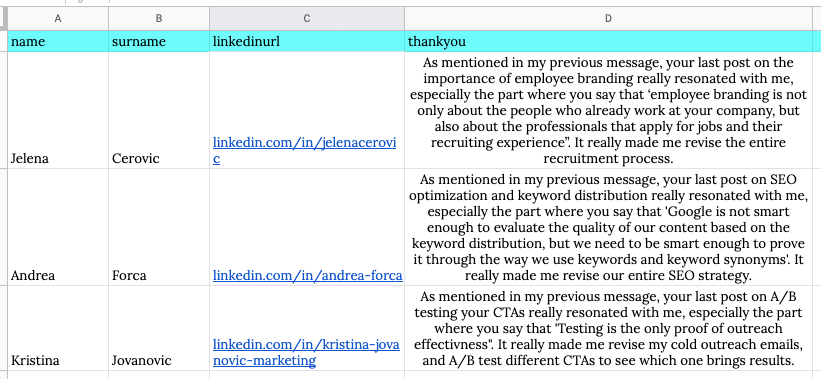
This is what your message will look like in Skylead, as part of the Smart sequence.
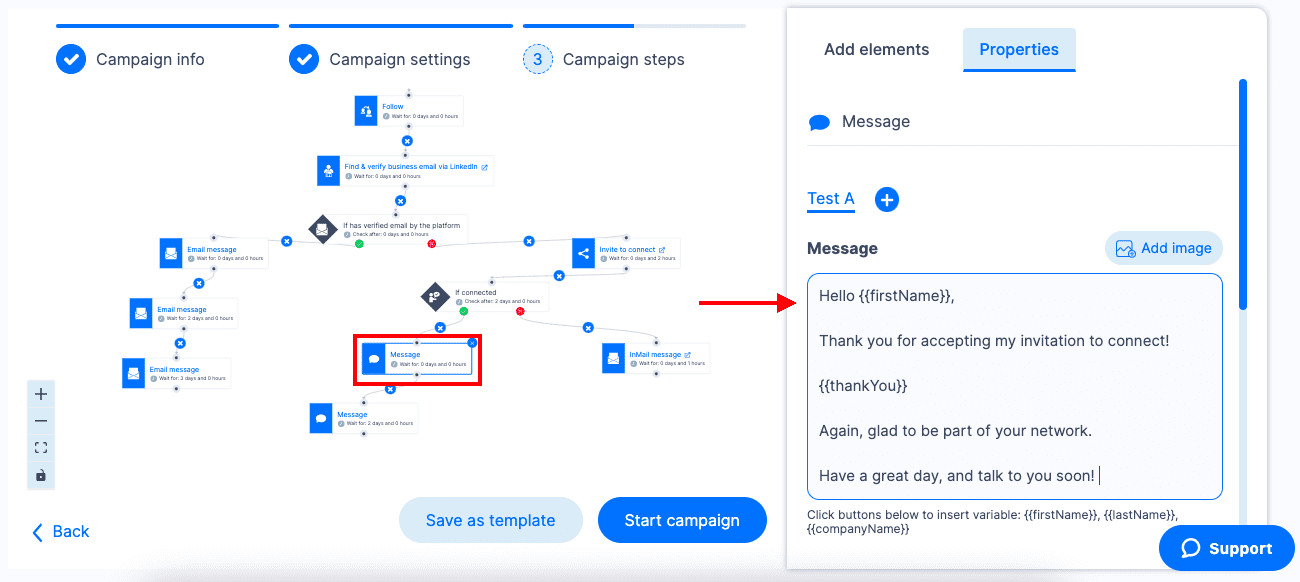
And this is how your user would see this message on LinkedIn.
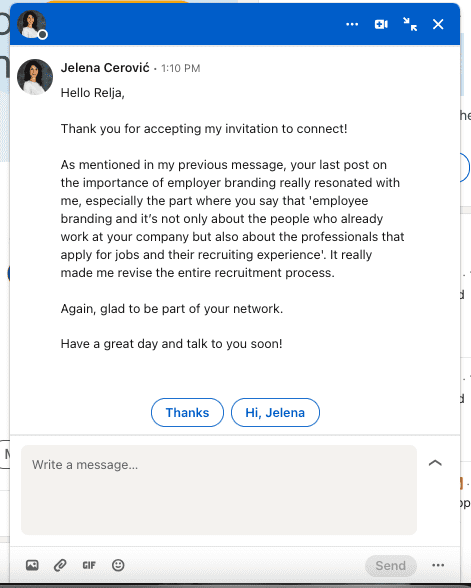
Summary
Sending a thoughtful Thank you for connecting on LinkedIn not only demonstrates your appreciation for becoming part of someone’s network but also becomes a strategic step.
Now, imagine enhancing this strategy even further with Skylead, our cutting-edge outreach tool, which you can try for 7 days for FREE starting today!
Our support team will help you at any step of the way, and make sure you use Skylead to its fullest potential to elevate your networking game, amplify your engagement, and turn connections into valuable opportunities!
